PDF VERSION: http://newenergytimes.com/news/2008/NET27.pdf
HTML VERSION: http://newenergytimes.com/news/2008/NET27.shtml

The leader in
news and information on
low energy nuclear reactions
March 10, 2008 -- Issue #27
Copyright 2008 New Energy Times (tm)
Published by the New Energy Institute Inc. six times per year
Staff
Editor and Publisher: Steven B. Krivit
Copy Editor: Cindy Goldstein
Web Editor: Sally Robertson
Support Team
Randy Souther
H.P.
Nick Palmer
V.F.
Contributors
Dieter Britz
Peter Gluck
Thomas Dolan
Frank Znidarsic
Anna Alexandrovna Alimuhambetova
Elena G. Sergeeva
Sergey A. Tsvetkov
Lawrence P.G. Forsley
New Energy Times (tm)
369-B Third Street, #556
San Rafael, CA 94901
(310) 470-8189
|
New Energy Times (tm) is a project of New Energy Institute, an independent 501(c)(3) nonprofit corporation that provides information and educational services to help bring about the clean-energy revolution.
|
__________________________________________________________________________________
New Energy Institute gratefully acknowledges the generosity and support of our major sponsors:
New York Community Trust
Anonymous
__________________________________________________________________________________
EDITORIALS AND OPINION
1. From the Editor: Will India Surprise the U.S. (Again)?
2. To the Editor: Comments on Iyengar Video Interview
NEWS & ANNOUNCEMENTS
3. Doc Patterson, Light Water LENR Pioneer
4. My Recollections of Jim Patterson by Lawrence P.G. Forsley
5. Conversations: Pioneers of and Contributors to Cold Fusion, CMNS /LENR
6. American Physical Society March 2008 Meeting
7. American Chemical Society "Fall 2008 National Meeting & Exposition"
8. 14th International Conference on Condensed Matter Nuclear Science
9. New Energy Foundation Announces Cold Fusion Oral History Project
10. New Energy Times Index of Commercial LENR Research Groups
11. ENECO Files for Chapter 11 Protection
12. Russ George's D2Fusion Disappears; Planktos Runs Aground
13. Public Service Announcements
ANALYSIS AND PERSPECTIVES
14. The 2008 India LENR Lecture Tour
15. Drama On Wikipedia Street
16. Energy Agency Review Panel Decides Against Funding Curie "Discovery"
17. News From the Future—Congress Makes History
18. The Koldamasov Cavitation Device
19. Excerpts of Student Paper: Report on the Work of A.I. Koldamasov
20. Proton-21 Research Presented in University of Illinois Seminar
21. PUBLICATIONS
22. SCIENCE AND ENERGY NEWS
__________________________________________________________________________________
“The scientist must be free to think and put forward whatever
ideas he considers right.”
“Ideas are some of the most important things in life and men are
prepared to suffer and die for them.”
“Good ideas cannot be suppressed—even by violence.”
— Homi Jehangir Bhabha |
__________________________________________________________________________________
EDITORIALS AND OPINION
1. Editorial: Will India Surprise the U.S. (Again)?
By Steven B. Krivit
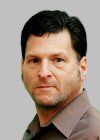
Photo: Daniel Bosler |
The recent lecture tour by Michael McKubre of SRI International,
Mahadeva Srinivasan, former associate director of the physics group at the Bhabha Atomic Research Centre on low energy nuclear reaction research, and me found an interested and receptive audience at the center and other science institutions in India.
But what's happening in the U.S. and other more developed nations with LENR research? Rumors reaching New Energy Times suggest that people in the U.S. government are taking notice - but quietly. A few of them now have active LENR research programs.
|
Only one U.S. government group, the Navy's SPAWAR San Diego (a different entity from the Naval Research Laboratory in Washington, D.C.), has published LENR papers (19) and does research openly. Some of the other government groups recently received internal funding to begin research, but they have been told not to publish.
Is this a good thing for science? For the U.S.? Probably not. On the other hand, the science community in India has come to terms with the fact that it missed out on 14 years of research on LENR. Will science leaders in the U.S. and other nations take notice of India's newfound interest?
Glowing articles about the LENR revival in India have been published in Nature India and New Energy Times. However, no journal papers from India have been published recently.
In 1974, researchers at the Bhabha Atomic Research Centre in Trombay, India, not-so-quietly unveiled a not-so-little secret: They had developed nuclear weapons technology. U.S. intelligence and the rest of the world was caught by surprise. Will India surprise the U.S. again with LENR?
| The U.S. may take a wait-and-see attitude with LENR research. The rest of the Western World also may wait. India is not likely to wait. Its people cannot afford to take precious food and burn it in their cars. Their hydro power is maxxed out. Their coal, while plentiful and providing 67 percent of India's total electrical power, is low-grade and dirty.
Think pollution is bad in Los Angeles? You ain't seen nothin' if you haven't been to a major city in India. They don't have enough uranium for their current-generation fission reactors, and according to Rajagopala Chidambaram, principal scientific adviser to the government of India, it will take at least another 20 years to bring the next-generation reactors online to take advantage of India's thorium reserves.
|
|
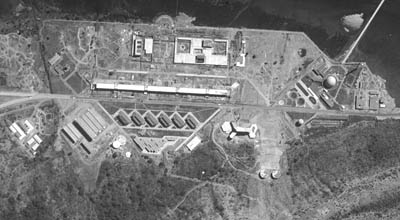
Bhabha Atomic Research Centre on the shores of the Arabian Sea
Satellite photo, 1966
|
Smart people in India understand science, technology, and innovation. And they have ambition and necessity, key ingredients for technological growth.
But India has not always been a country rich in high technology. B.V. Sreekantan, a visiting professor at the National Institute of Advanced Studies and former director of the Tata Institute of Fundamental Research,
writes in a book honoring the life and work of legendary Indian physicist and leader Raja Ramanna, about their country's isolation from technology.
"In the late 1940s and the early 1950s,” Sreekantan says, “India was industrially backward, and in the field of electronics, only had imported radio communication electronics available. There was no expertise on pulse electronics anywhere in the country. Even scientific books and journals took their time to reach India by sea, and the journals were almost a year old by the time these reached our libraries.
“To work in this environment on advanced areas of nuclear physics and cosmic rays, and keep pace with our competitors in Europe and USA, was quite a challenge. ... A saving grace was the large availability of discarded electronic components ... left by the homebound U.S. and U.K. military services."
India is obviously a latecomer to the technology game. One reason for this is its previous isolation from the West. Another reason is its unwillingness to subjugate its options for defense to appease other countries that have used nuclear weapons for nonpeaceful purposes.
People in the West may have a tendency to think less of India's capabilities because of what they see on the surface. But folks in the West would be wise not to underestimate India's ability or wisdom. Just because India, statistically speaking, doesn't measure up to other more-developed countries or appear as technologically advanced does not mean that it lacks the capability or desire.
Another reason for its underdeveloped state, perhaps the most significant, is that living simply is (at least until recently) a dominant cultural value. You don't need to talk an Indian into reducing, reusing and recycling; people there are practically born with what we called in the 1970s a conservation attitude and call now sustainability.

Yes, that is a mobile phone the bullock cart driver has to his ear.
Photo: S.B. Krivit
|
|
But they have tasted the riches of the West, and times are changing in India. They want their iPods, and they want their flashy cars. And they need energy, too. Well maybe they all don't want flashy cars, but they do want mobile phones.
They've learned a whole lot about self-reliance, particularly in the realm of nuclear technology, thanks to the West's isolation of India in nuclear technology. This denial has led to the development of its own indigenous talent, or as Chidambaram calls the approach, "immunity against technology denial."
The people in India also look at nuclear power differently from people in the West. Consider what Chidambaram said in a presentation to some of his country's technology leaders on 8 Jan.
|
"The need to customize policies and goals for each country is illustrated by the difference between India and the U.S. in their approach to the fast breeder nuclear reactor,” he said. “India places a high value on reprocessing spent fuel to close the nuclear fuel cycle, because it has limited uranium reserves and the world's largest thorium reserves.
”The United States, with easy access to relatively cheap uranium (though the price has risen sharply in the past couple of years), is content to store the spent fuel as 'waste' for decades."
Padmanabha Krishnagopala Iyengar, former director of BARC and former chairman of the Atomic Energy Commission explained in a video interview in January how the U.S. and India utilize uranium-based fission technology differently.
"[The U.S.] is burning less than one percent of the uranium that it mines," Iyengar said. "It is misleading the world."
Iyengar said that India utilizes 99 percent of its uranium as fuel whereas the U.S. uses only one percent and stores the remainder as "waste" or uses the depleted uranium in military applications.
In another slide from Chidambaram's presentation, he explains what he sees as a significant factor for his country's nuclear energy independence in the long run. Right now, India is highly dependent on foreign uranium for its reactors, but things could be markedly different in a few decades.
|
"India needs the world in the short term, and undoubtedly the world will need us in the long term, in the context of the emerging Nuclear Renaissance which is being driven by the depletion of fossil fuel resources and the threat of global climate change," he says.
The bottom line for nuclear fission energy is this: Based on some estimates (without reprocessing spent fuel), the world has only enough uranium to last another 80 years. On the other hand, fission technology that includes reprocessing of uranium and thorium could provide enough fuel for 8,000 years.
And what might happen in India with LENR? Nobody knows. What is certain, however, is that at least three of the top six people responsible for India's historic 1974 nuclear device test—P.K Iyengar, M. Srinivasan, and R. Chidambaram—have been briefed recently on LENR.
|
|
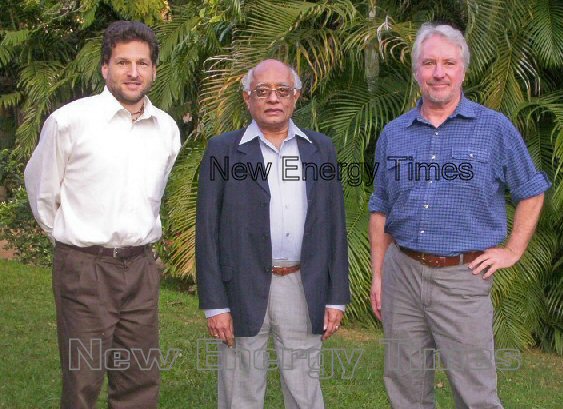
S.B. Krivit, R. Chidambaram and M. McKubre
Photo: M. Srinivasan
|
Photo Albums of India:
Kalpakkam Village, India: Site of major damage and fatalities from 2004 tsunami
General sights and people from several areas in southern India
__________________________________________________________________________________
2. To the Editor: Comments on Iyengar Video Interview
[Ed. note: See below for more details and a link to this video of an interview with Padmanabha Krishnagopala Iyengar, former director of India's Bhabha Atomic Research Centre (BARC) and former chairman of the Indian Atomic Energy Commission.]
To the editor:
I think that the video is quite good and it could certainly benefit from subtitles. Iyengar carries great credibility and is quite vocal. His points concerning the futility of non-proliferation are serious and should be given careful thought. I am afraid that the U.S. government has taken the position of "see no evil, hear no evil, speak no evil" when it comes to discovery, unless it is of the failings of opponents.
The excitement of the discovery of neutrons and tritium in their experiments is still strong after 19 years. It is critically important to have recordings like this for historical purposes.
It is good to hear him talk frankly about some of the difficulties of modern nuclear physics. This is one of the benefits of his retirement and his still very sharp mind. His career will not suffer by his speaking his mind. I have made numerous efforts to understand nuclear physics, but it is daunting. I think that a lot of the problem is that the knowledge is so fragmentary, yet organized by scientific hierarchy into an accepted "standard model," which disallows the kind of "lateral thinking" required to have it make sense. Or, at least that is how I interpret what Iyengar said. We are left with a lot of nonsense mixed with the good results, all of which are defended like the middle-ages Catholic dogma. LENR may be the discovery that brings the serious problems of theoretical physics into a stark light, to bring the long-term crisis of physics to a head.
I found it particularly interesting that he said that the stigma about LENR came from the West, and he seems to attribute much of the mal-adaptations of modern science toward research to Western bureaucratic methods, which I would agree with, with some modification. I think that the arrogance associated with the "winner" mentality held by those who "win" the "game" of life by accumulating the most toys has, in effect, subjugated the scientific mind to the managerial mind. I see it routinely in scientific work. Facts of physics are treated as mere opinions, on par with many other considerations when deciding a course of action, instead of recognizing the fundamental nature of physical science.
Indian society rejects, to a considerable extent, materialism; whereas we embrace it to an obscene degree. Iyengar well understands the great value of basic research, which has become all but lost in our society.
Almost all of Western research is now oriented toward producing things, rather than understanding what is. This is futility, because nature does not give us problems to solve of our choice, a choice made to indulge our appetites and fantasies, and cure our diseases. Our survival hinges on very broad understanding of nature. He rightly points out, which Douglas Morrison of CERN and other detractors ignore, that new discoveries sometimes take a very long time to elucidate, and that this is largely because the sacrosanct theory is seriously deficient.
Ed Wall
Denver, CO
__________________________________________________________________________________
NEWS & ANNOUNCEMENTS
3. Doc Patterson, Light Water LENR Pioneer
By Steven B. Krivit
James "Doc" Patterson died on Feb. 11 after several days of illness related to a heart attack, according to one of his daughters, Mandy Davis. Patterson is also survived by daughters Sherrill and Valerie and son Vance. Patterson had been an early pioneer in cold fusion research and dared to go where few others were willing: using light water instead of heavy water in his experiments.
Davis, who had worked with "Doc" in his LENR lab and also on his biomedical products, will follow through with the LENR patent applications and licensing agreement that were in process at the time of Patterson's passing. Davis mentioned a LENR cell that "Doc" had been working on—powered initially by solar photovoltaics—that was self-sustaining.
"You might find it interesting to know that right up until the last couple of weeks of his life he was continuing to work on LENR," Davis said. "The world lost a pretty amazing mind."
__________________________________________________________________________________
4. My Recollections of Jim Patterson
By Lawrence P.G. Forsley
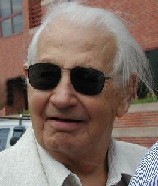
James "Doc" Patterson
Photo: D. Nagel
|
|
I developed a working relationship with Jim Patterson and his company, Clean Energy Technology Inc., in the mid-1990s, before the development of the company's cold fusion demonstration kit called RIFEX (Reaction In a Film Excited complex).
As I got to know Jim better, I learned of his predilection for fishing and the virtues of tiny plastic microspheres, informally called beads, used for industrial applications. I had become interested in these beads as a substrate for use in low energy nuclear reaction experiments after he and George Miley of the University of Illinois had begun collaborating on an alternative means to make a LENR surface. George had been struggling with thin films, and along came Jim with his sulfated, metal-coated beads.
George and I had both worked in inertial confinement fusion (a.k.a. laser fusion), and I think we both saw the obvious advantages that a symmetrical bead as a substrate had versus a perpetually delaminating planar surface.
|
I met with Jim and his grandson, Jim Reding, who regrettably died several years ago, in Dallas, Texas, to discuss what we might do together. Eventually, we licensed a specific technology and, with one of my electrochemist colleagues, began doing experiments in my friend's laboratory, at my lab in Annandale, Va., and in Jim Patterson’s “garage laboratory,” in Sarasota, Fla.
I set out a goal for Jim, which he carried out and was even granted the patent on. I chose to not get involved with the patent application, because I didn’t believe his instrumentation reflected what the patent asserted.
His lab in Sarasota was wonderful. It was the size of an oversized garage - or an undersized airplane hanger. It was a marvelous combination of 1950s technology coupled with the best of 19th century physics and chemistry.
A modern day Faraday would have been right at home among the variety of ovens, wires, cables, chemicals, stirrers and more. There was even an office with a recliner that Jim liked to nap on, and a dog or two to keep an eye on things.
I’d say we spent equal amounts of time talking about fishing, chemistry and eating and the rest of our time futzing in his lab. In between, we had many discussions about LENR, its prospects and the future.
On one trip, Jim handed me one of his inventions: a spool of porous fiber for drip-feeding plants. Over dinner another night, I asked him about ketchup. This requires some explanation.
I had learned from another colleague that Jim had made a name for himself while a graduate student many years earlier. Jim, while working for Dow Chemical, had patented the first of his beads as turbidity standards, used to measure the cloudiness of water.
Another friend of mine had Jim's beads and found that the size distribution wasn’t "standard” enough, and as a result, they had an immediate falling out. But, on learning about the ketchup project from his grandson, (I'm getting to this) and realizing that Jim was “Dr. Plastic Bead,” I had a very unsettling thought.
Had he devised a means to thicken ketchup by the addition of turbidity standard beads, I wondered? Had he used the nonstandard beads that failed to meet spec for use in the ketchup that I was eating?
I was sure they were fit for human consumption, but ingesting multimicron-sized plastic beads just was not very appealing. With some trepidation, I asked Jim about this during dinner.
“Jim," I said, "I understand you devised a means for thickening ketchup for one of the major food companies.”
“Yup,” he answered.
“Can you tell me how you did this?” I timidly asked.
“Nope,” he replied.
“Well, did you use polystyrene beads by any chance?” I asked with a low voice after I had just poured ketchup onto my french fries.
“Ah, no,” he said. “I used freeze-dried tomatoes to make it thicker. No one would put polystyrene beads in ketchup. What gave you that idea?”
“Just a thought,” I replied, as I happily consumed my french fries without fear.
Jim and I continued to kibitz for a couple of years. At ICCF-7 in Vancouver, B.C., in 1997, I presented data from my experiments in which I had used Jim's beads. However, before that conference, Jim and I had a meeting in Washington, D.C., coinciding with an American Nuclear Society meeting.
I had concluded, as I would state in my ICCF-7 talk, that I had seen no evidence of LENR-induced isotopic shifts from an analysis of gases, solids or electrolyte using nuclear activation analysis (NAA), high resolution inductively coupled plasma mass spectroscopy (ICP/MS) or x-ray fluorescence (XRF).
Jim was quite irate when I said this.
“I didn’t pay you to get those kind of results!” he said.
“Jim, you didn’t pay me," I replied. "I paid you for a research license and for those damn beads!”
Nonetheless, Jim’s passing was a great sadness to me. He was a prolific inventor, and I learned a great deal from him. His company’s decision not to sell its RIFEX intellectual property to Motorola for $10 million was thought at the time to be the height of idiocy. But Jim wanted to keep the ranch, right down to the last chicken.
These thoughts are always with me as I look into my cloudy crystal ball. But at least I can enjoy my french fries and think fondly of Jim when I can’t get the ketchup out of the bottle.
Take care, my friend! I hope the fishing is as good where you are now as it was in Sarasota. Otherwise, move back.
__________________________________________________________________________________
5. Conversations: Pioneers of and Contributors to Cold Fusion, CMNS /LENR
New Energy Times is gradually building an index of many of the pioneers of cold fusion, CMNS/LENR. Yuri Bazhutov recently contributed several listings in remembrance of outstanding Russian scientists who had made a "substantial contribution into research of cold nuclear transmutation, a new field of scientific endeavor." The index can be found on the "Conversations" page of the New Energy Times Web site.
__________________________________________________________________________________
6. American Physical Society March 2008 Meeting
For the 11th year a row, Scott Chubb has again championed the cause of cold fusion at the American Physical Society. Chubb has organized a session that will include 15 presentations from international scientists, aimed at helping to bridge the gap between this new field and mainstream science.
The March Meeting of the American Physical Society (APS), usually the largest physics meeting of the year anywhere, will take place at the New Orleans Convention Center, March 10-14, 2007.
__________________________________________________________________________________
7. American Chemical Society Fall 2008 National Meeting & Exposition
As he did last year, Jan Marwan has again organized a Symposium on New Energy Technology at the American Chemical Society national meeting. This year's "fall national meeting" takes place in Philadelphia, PA in late summer, Aug. 17 - 21, 2008. Registration and travel information is not yet available. The symposium announcement is at this Web site.
Presenters are required to submit a short abstract to the ACS by March 17, 2008, using the ACS online system. This division also requires an extended abstract of two or more pages that must be submitted online.
After last year's American Chemical Society meeting, the ACS commissioned the publication of a book of papers based on the symposium. Jan Marwan and Steven B. Krivit are editors of the book, which will be published by Oxford University Press toward the end of this summer.
__________________________________________________________________________________
8. 14th International Conference on Condensed Matter Nuclear Science
The 14th International Conference on Condensed Matter Nuclear Science will be held Aug. 10-15 at the Hyatt Regency Hotel on Capitol Hill in Washington, D.C. The purpose of this conference is to present and discuss new results on low energy nuclear reaction (LENR) research, previously called "cold fusion."
The ICCF conferences, which began in 1990, have been held alternately in North America, Europe and Asia. It is the primary venue for the international research community to give and critique papers in the CMNS field. Papers will be published in a printed proceedings. The chairman of the conference is David J. Nagel, research professor at The George Washington University. The co-chairman is Michael E. Melich, professor at the U. S. Naval Postgraduate School. A call for papers has not yet been issued as we go to press.
Resources: Conference Web site, Conference hotel
__________________________________________________________________________________
9. New Energy Foundation Announces Cold Fusion Oral History
(based on the New Energy Foundation Feb. 15, 2008, press release)
On Feb. 15, the New Energy Foundation announced the Cold Fusion Oral History Project, which will include interviews with scientists, researchers, program and government administrators, journalists and other key figures whose work influenced the history of research in Condensed Matter Nuclear Science.
The University of Utah’s J. Willard Marriott Library Special Collections will be the official repository for the collection when the project is completed.
“This arrangement brings to fruition the hopes that the New Energy Foundation and I had at the beginning of the project to have the benefit of the University of Utah’s expertise and capabilities,” project director Marianne Macy said.
The University of Utah plays an important role in cold fusion history, because Martin Fleischmann and Stanley Pons made their historic cold fusion announcement there on March 23, 1989. According to the New Energy Foundation, they will process and publish the materials, and the University of Utah will become the center of cold fusion science historical research.
The New Energy Foundation initiated the project in May 2007 and provided initial funding, which will be supplemented by the University of Utah. An unnamed seven-member advisory panel, comprising researchers and advocates in the field, aided Macy in identifying all of the individuals to be included in the oral history. Interviews, which are researched and conducted by Macy, have been under way since June 2007. Macy, who according to the press release has worked in the fields of oral history and journalism since 1980, will assure that the agreements under which the interviews were conducted are fully adhered to.
New Energy Foundation general manager Christy Frazier noted, "We believe it is of important historic value that the University of Utah will become the repository for this collection, and we are also excited about the fact that it will be completed around the 20th anniversary date of the cold fusion discovery. Most people in this field have been working diligently and producing great results for these past 20 years, and it is extremely important that their life's work and contribution to science be recorded for posterity."
The New Energy Foundation will retain the right of first publication of released oral history materials. Selected sections of some interviews, with the subject’s permission and review, will be published in Infinite Energy magazine to coincide with both the 14th International Conference on Condensed Matter Nuclear Science (ICCF-14) in Washington, D.C., in August 2008 and the 20th anniversary of the Fleischmann-Pons announcement on March 23, 2009.
The University of Utah J. Willard Marriott Library's role will include the digitizing of transcripts and creation of the appropriate technology base for keyword searching. After the New Energy Foundation’s initial publication and role in creating awareness of the archive, the Marriott Library will host the digital access through the University's online publication system. The original oral records and transcripts of the interviews will be held in the J. Willard Marriott Library's Special Collections.
Gregory C. Thompson, associate director and head of special collections at the J. Willard Marriott Library, indicated that this important relationship among the New Energy Foundation, Marianne Macy and the University’s J. Willard Marriott Library will continue to develop the University’s cold fusion oral history collection and archives.
For more information about the New Energy Foundation Cold Fusion Oral History Collection, please contact the New Energy Foundation at (603) 485-4700, or staff@infinite-energy.com.
__________________________________________________________________________________
10. New Energy Times Index of Commercial LENR Research Groups
As a result of the growing commercial interest in LENR, New Energy Times will now maintain an index of worldwide commercial LENR research groups, to the best of its ability. A link for the index can be found on the home page on New Energy Times. We expect to update this index concurrently with each issue of New Energy Times.
__________________________________________________________________________________
11.
ENECO Files for Chapter 11 Protection
Salt Lake City-based ENECO, one of the oldest LENR-related firms, filed for chapter 11 bankruptcy on Jan. 18. The firm's focus is now primarily on thermal to electric conversion devices.
New Energy Times spoke on Jan. 30 with Harold "Lew" Brown, who explained that funding challenges were a significant factor that led to the filing. They are still in operation; however, they plan to reorganize and move on, according to Brown, after presenting a new plan to the court.
ENECO lists several members of the LENR community among its team including Yan Kucherov, Peter Hagelstein, Michael Melich and David Nagel.
__________________________________________________________________________________
12. Russ George's D2Fusion Disappears; Planktos Runs Aground
Since mid-January, the Web presence for D2Fusion has completely disappeared, leaving in its place only a simple notice that the Web site is "down for maintenance."
The Web site for George's other company, Planktos, went through a two-phase regression. In late January several key pages were removed, including the
pages for "Investors," "Store" and "California Challenge." The page listing "Scientific Advisors," which had included Scott Chubb of Research Systems Inc., also was removed.
The only remaining "team" members listed on the site were Russ George and Michael Chinn. The listings for Tom Passell, Nelson Skalbania, John J. Camozzi, and David Kubiak had been removed.
On Feb. 13, the site removed everything and in its place left only a simple one-page note indicating that they had abandoned their effort to pursue their idea of ocean iron fertilization. It had been their expectation that their ocean iron fertilization plan would reduce greenhouse gases, provide carbon credits to carbon producers, and give profits to people who invested in Planktos.
The message on the Planktos site blamed "a highly effective disinformation campaign waged by anti-offset crusaders" for the company's demise.
In this index, readers can view the rise and fall of Planktos, from the first investigation by New Energy Times on May 10, 2006 to articles about the de-listing of its stock, allegations of fraud, and the halting of the ocean fertilization project as reported in The New York Times on Feb. 13.
__________________________________________________________________________________
13. Public Service Announcements
Interfacial Electrochemist in Spain Seeks LENR Work
"I am an interfacial electrochemist in Spain and I am very interested in studying the surface phenomena that occur on Pd electrodes during the electrochemical co-deposition of Pd and deuterium experiments and I seek professors I can contact on this subject and/or labs where I can work. U.S. preferred, but other locations okay too." - DM. Please contact me care of New Energy Times.
LENR Down Under
New Energy Times has received multiple requests from people in Australia wishing to get involved in LENR research and to collaborate with each other. If this is you, send an e-mail to us with your contact information and we will facilitate introductions (our contact information is here).
__________________________________________________________________________________
ANALYSIS AND PERSPECTIVES
14. The 2008 India LENR Lecture Tour
By Steven B. Krivit
In January, I flew to India on a speaking tour to discuss low energy nuclear reaction (LENR) research. I suppose the seeds of this trip were sown three years ago when Nadine Winocur and I finished our book, "The Rebirth of Cold Fusion." At the time, in 2005, we sent a few copies to people we knew in the condensed matter nuclear science community.
One of these people was Mahadeva (M.) Srinivasan, former associate director of the physics group at the Bhabha Atomic Research Centre (BARC), India. M. Srinivasan, along with Padmanabha Krishnagopala Iyengar, former director of BARC and former chairman of the Atomic Energy Commission led the cold fusion research in India from 1989 to 1994 before it fell out of favor.
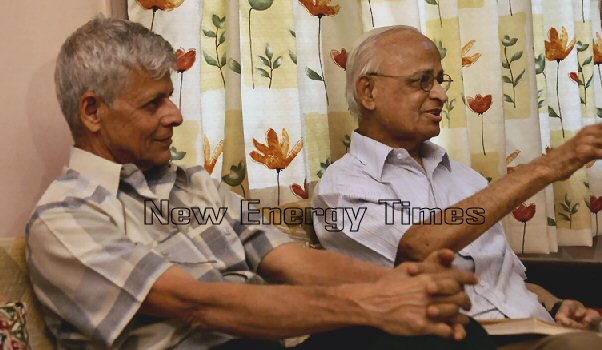
Mahadeva Srinivasan and Padmanabha Krishnagopala Iyengar
Photo: M. McKubre
|
|
M. Srinivasan was enthusiastic when he received a copy of our book and began to re-acquaint his colleagues in the Indian atomic energy community with the topic.
One of the people whom M. Srinivasan contacted was Malur Ramaswamy (M.R.) Srinivasan, a member of the Indian Atomic Energy Commission and a past chairman of the commission.
"M.R. Srinivasan wanted me to send him a quick short note of the status and why I think the Indian Department of Atomic Energy should re-enter the field," M. Srinivasan wrote to me. "I can't think of a better summary of it all than your book!"
|
We air-mailed a book to M.R. Srinivasan and received a nice letter from him shortly afterward.
"It was very kind of you and Nadine Winocur to send me a copy of your book "The Rebirth of Cold Fusion," M. R. Srinivasan wrote in April 2005. "I have read the book with great interest. I compliment both of you for writing a very readable book conveying the drama surrounding the subject.
"I propose to discuss this new insight into cold fusion with some of my colleagues in this part of the world to find out how interest could be stimulated to look at this problem afresh."
Nothing appeared to happen for two years until early 2007 when M. Srinivasan asked whether I'd be willing to come to India to give a talk on LENR. He had been contacted by Ethirajan Rajan, the founder and president of Pentagram Research, a private organization that sponsors conferences that bring together scientists, members of industry and students to examine a variety of technical and scientific topics. Rajan is also the innovator of a mathematical model, known by his name as a Rajan transform, which is used for pattern recognition and analysis.
|
|

Ethirajan Rajan giving impromptu lecture to students
Photo: S.B. Krivit
|
M. Srinivasan also invited two researchers from the CMNS community to participate in the LENR seminar that Rajan was arranging, but by the fall of 2007, these researchers backed out. On short notice, M. Srinivasan invited Michael McKubre, director of the Energy Research Center at SRI International, Menlo Park, Calif., who accepted the invitation to participate in the LENR seminar at Rajan's International Conference on Systemics, Cybernetics and Informatics.
In the same period, M. Srinivasan began booking more speaking engagements for McKubre and me. I also made arrangements to set up a video interview with Iyengar because he was a key pioneer in the history of cold fusion research.
The progression of the trip, from one speaking engagement at Rajan's conference to the whistle-stop tour of southern India, is a mystery to me, but certainly M. Srinivasan deserves much credit for making it happen. M. Srinivasan was also able to arrange partial financial support for the trip from India's Department of Atomic Energy Board of Research in Nuclear Sciences as well as Pentagram Research Corp. The outline of our tour is listed below.
|
2008 India LENR Tour Schedule
Jan. 3
- International Conference on Systemics, Cybernetics and Informatics, at Taramati Baradari Cultural Complex, Hyderabad, Andhra Pradesh
- "Seminar on Low Energy Nuclear Reactions"
- Lectures: Krivit, McKubre, M. Srinivasan
Jan. 4
- International Advanced Research Centre for Powder Metallurgy and New Materials in Hyderabad
- Lecture by McKubre
Jan. 5
- Meeting in Hyderabad with Anil Kakodkar, Atomic Energy Commission Chairman, Secretary of the Department of Atomic Energy
Jan. 6
- Meeting in Trombay with Sri Kumar Banerjee, Director of BARC
Jan. 6
- Video interview in Trombay with P.K. Iyengar, former director of BARC, former Atomic Energy Commission chairman
Jan. 7
- Visit to Bhabha Atomic Research Centre - Trombay
- Lecture by McKubre
Jan. 8
- Meeting in Bangalore with Rajagopala Chidambaram, principal scientific adviser to the government of India, chairman of the Scientific Advisory Committee to the cabinet, former Atomic Energy Commission chairman, former director of BARC
Jan. 9
- LENR Workshop at the National Institute for Advanced Studies on the campus of the Indian Institute of Science in Bangalore
- Lectures: McKubre, Krivit, M. Srinivasan, Kalya Jagannatha Rao
Jan. 11
- Visit to Indira Gandhi Centre for Atomic Research in Kalpakkam
- Lecture by McKubre
Jan. 11
- Briefing with students and teachers at Indian Institute of Technology - Madras (IITM)
- Lecture by McKubre
Jan. 12
- Meeting in Madras (Chennai) with M.S. Ananth, director of IITM
|
The unique aspect of our lecture tour in India was that, in contrast with 13 other nations, not a single LENR research project, to our awareness, had taken place in India since 1994.
One of the attendees of our Jan. 9 workshop, C.K. Mathews, succinctly explained the problem. Mathews is a managing director for Indus Scientific Pvt Ltd. and was the director of the chemistry group at the Indira Gandhi Centre for Atomic Research in Kalpakkam, one of the largest nuclear research centers in the country.
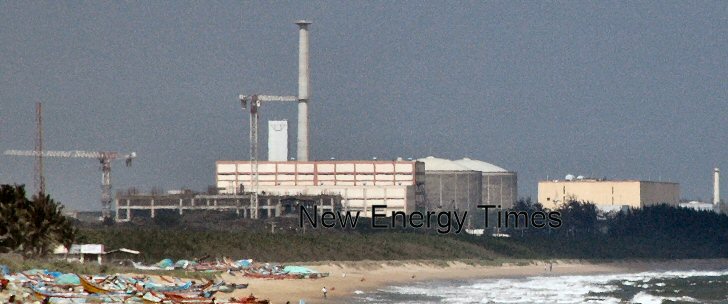
Indira Gandhi Centre for Atomic Research in Kalpakkam
Photo: S.B. Krivit
"In the beginning, we did some cold fusion research, and we published our results," Mathews said, "but the negative pressure on us was so overwhelming that we had to give up everything. I am glad there is a revival."
A few of the people we met with had been extremely hostile toward the subject in the early days, many had been neutral and some had been open-minded and optimistic. But everywhere on our tour, we were received warmly and enthusiastically.
All in all, we never faced any hostility with regard to LENR. Only one person we met, a nuclear physicist at BARC, remained openly skeptical after the lecture. In general, a nearly unanimous consensus emerged; the attitude in India regarding LENR flipped. The questions shifted from "How could it be real?" to "How should we restart our research programs?" and "How can we best serve the needs of our country?"
It was a tremendous honor to meet these scientists and government representatives, only some of whom this report will mention by name. We met dozens of others at the various laboratories and universities we visited.
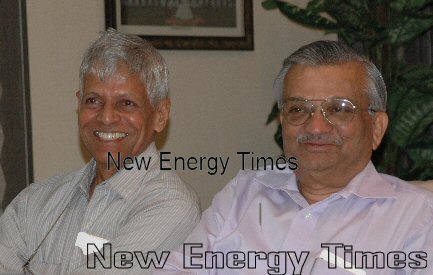
Mahadeva Srinivasan and Anil Kakodkar,
Atomic Energy Commission Chairman
Secretary of the Dept. of Atomic Energy
Photo: S.B. Krivit
|
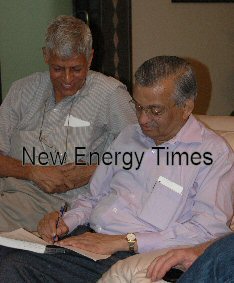
Kakodkar autographs "Rebirth
of Cold Fusion"
Photo: S.B. Krivit
|
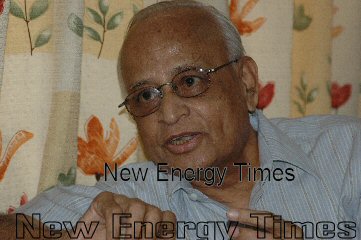
Padmanabha Krishnagopala Iyengar
Photo: S.B. Krivit
|
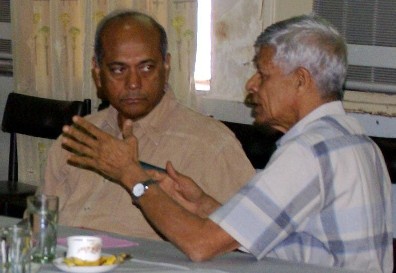
Sri Kumar Banerjee and Mahadeva Srinivasan
Photo: M. McKubre
|
My conversation with Iyengar was fascinating; see the note at the end of this article for a link to the video. One of the things I distinctly remember from the conversation is his response to how to solve the seemingly unsolvable mystery of LENR. "Lateral thinking" was his response. In other words, thinking outside the box and seeking answers from new places, not merely trying to solve the problems with a new variation of the same old approach.
I found a surprising amount of talent in high places in India with regard to materials science, which is highly applicable to LENR research. Sri Kumar Banerjee, the director of BARC, is, for example, a specialist in hydrogen in metals. The BARC research facility, perhaps the largest in India, employs 15,000 people, of which 4,500 are researchers.
Even though Banerjee did not have direct experience with LENR, that domain was not such a foreign concept to him. During our breakfast meeting, he immediately understood one of the key problems with the field.
"Breakthrough science cannot be peer-reviewed," Banerjee said. "Only known science can be peer-reviewed."
At the International Conference on Systemics, Cybernetics and Informatics, I had the chance to speak to a few hundred very bright students, mostly science and engineering college students, many of whom had traveled for several hours to attend the conference. They caught on quickly to the subject matter and were immediately asking me how and where they could start working on LENR research. I had no clear answers for them, because this conference was at the beginning of our tour. By the end of the tour, it became obvious that that national labs were likely to initiate programs.
The most important meeting on our tour was at the National Institute for Advanced Studies on the campus of the Indian Institute of Science in Bangalore. The title of the meeting was "One-Day Discussion Meeting on Emerging New Energy Concepts for the 21st Century—Low Energy Nuclear Reactions."
The meeting took place in the J.R.D. Tata Auditorium at the National Institute for Advanced Studies on Jan. 9. The program documents, abstracts and list of registrants is available in this pdf file. The audience comprised 40 of India's top scientists and laboratory managers. Their backgrounds included nuclear physics, metallurgy, chemistry and other disciplines.
The meeting was organized by B.V. Sreekantan, M. Srinivasan and Srinivasa Ranganathan. Sreekantan is a visiting professor at the National Institute of Advanced Studies and a former director of the Tata Institute of Fundamental Research. Ranganathan is a visiting fellow at the National Institute of Advanced Studies and a retired distinguished professor from the department of materials engineering at the Indian Institute of Science and Technology in Bangalore.
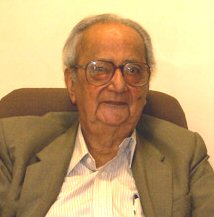
B.V. Sreekantan
Photo: M. McKubre
|
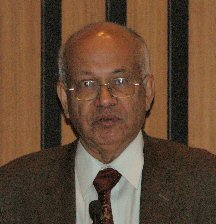
Srinivasa Ranganathan
Photo: S.B. Krivit
|
The National Institute of Advanced Studies is the brainchild of Sri Jehangir Ratanji Dadabhoy Tata, who was a legendary industrialist in India. In a book honoring the life and work of another Indian legend, physicist and leader Raja Ramanna, Sreekantan wrote about Tata's role in the formation of the National Institute of Advanced Studies.
"Tata was inspired by the Grand Ecoles in France and dreamed of setting up a similar institution in India that would serve the important purpose of imparting multidisciplinary training to the senior administrators who are the real decision makers in the government, in public and in private sectors and in industries - decisions which had direct influence on the future course of science, technology, industry and governance in the country."
On the afternoon before the NIAS workshop, we had tea with Rajagopala Chidambaram, principal scientific adviser to the government of India, chairman of the Scientific Advisory Committee to the cabinet, former Atomic Energy Commission chairman and former director of BARC.
McKubre, M. Srinivasan and I had the opportunity to have a brief chat with him about LENR, and I presented him with a copy of "Rebirth of Cold Fusion."
In a paper he wrote in Dec. 1989, Chidambaram expressed concerned that the Fleischmann-Pons experiment did not look like fusion as he knew it and he appeared concerned. After our recent meeting, he expressed his appreciation for the new information we provided him that showed experimental evidence of low energy nuclear reactions and that explanations other than fusion are now being considered.
Later that evening, Chidambaram gave an illuminating talk at NIAS titled "Nuclear Energy in India: Self-Reliance and International Cooperation." His perspective about India was refreshingly different from those of a variety of sources in the U.S.
At the end of his talk, he paid a special tribute to M. Srinivasan for his historic contribution to the country's nuclear research program that put India on the map of the world's nuclear superpowers in 1974.
On the 9th, Sreekantan welcomed his American guests with a quote from the ancient Vedic texts.
"Winds of knowledge must come from all directions," Sreekantan said. "I am standing heretoday not as an expert in LENR - in fact, my |
|
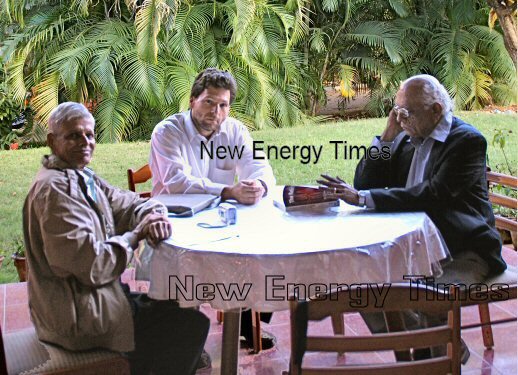
Mahadeva Srinivasan, Steven B. Krivit and Rajagopala Chidambaram
Photo: M. McKubre
|
own field has been the opposite, the interactions of cosmic rays - but I've kept an open mind on many issues, and one of these is this idea of cold fusion, which is now called low energy nuclear reactions."
Sreekantan said that he's been "stumped" three times in his career by theoretical anomalies, and he encouraged the audience not to rely so heavily on theoretical arguments.
"The final court of appeals in science is experiment," Sreekantan said. "So I think we should really look at the experimental evidence that is coming forward and see what we can learn from it."
In his brief introduction, M.R. Srinivasan explained that he had been witness to the most chaotic and perhaps ugly part of cold fusion history.
"I was the chairman of the [Atomic Energy] Commission at time of the Fleischmann-Pons experiment reports," M.R. Srinivasan said. "I was also the chairman of the Nuclear Power Corporation. I witnessed the great excitement over the experiments, and I also witnessed the subsequent decline of interest, including the controversy of the ethics situation and the publicity that surrounded it."
McKubre led off the morning group of presentations with "Cold Fusion: Past, Present and Future," a review of his understanding developed over 19 years of his involvement with LENR research.
The title of my talk was "Low Energy Nuclear Reactions Research – Global Scenario," which reviewed some of the current highlights that I thought were most important and interesting.
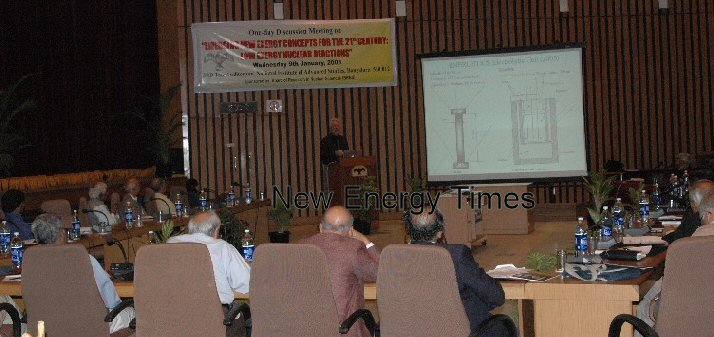
Michael McKubre speaking at NIAS - Photo: S.B. Krivit
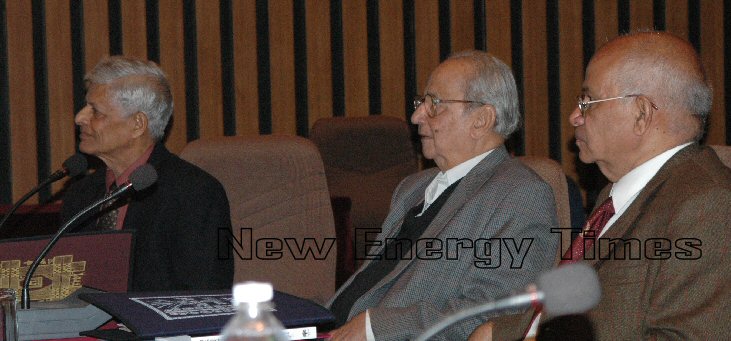
Srinivasan, Sreekantan and Ranganathan at NIAS
- Photo: S.B. Krivit
|
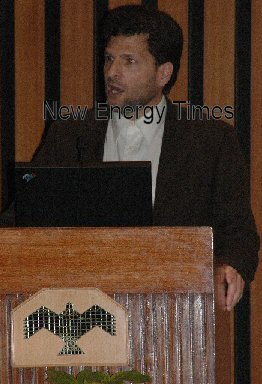
Steven B. Krivit speaking at NIAS
|
M. Srinivasan's presentation covered some fascinating ground on modern transmutation research and showed a relationship to transmutation in the pre-Fleischmann-Pons era. M. Srinivasan presented convincing information that made the ancient work of alchemy difficult to dismiss.
Kalya Jagannatha Rao, professor emeritus of the solid state and structural chemistry unit at the Materials Research Centre in the Indian Institute of Science, Bangalore, gave an unscheduled and highly enthusiastic presentation with his personal overview of the field. Edmund Storms, a retired radiochemist from Los Alamos National Laboratory, provided a videotaped presentation that was shown on his behalf at the end of the afternoon, after the panel discussion.
The bulk of the afternoon program consisted of a panel discussion with the three speakers from the morning program along with dignitaries Sreekantan, M.R. Srinivasan, Bikash Sinha and Sarukkai Krishnamachary Rangarajan.
Sinha is the director of the Variable Energy Cyclotron Centre in Kolkata. Rangarajan is a world-renowned theoretical electrochemist and is regarded with respect by his colleague Martin Fleischmann, among others. He is the retired director of the Central Electrochemical Research Institute of India in Karaikudi.
The dignitaries offered their views. One statement by Rangarajan carried with it a profound message. He expressed regret that he had not gotten involved to support the research earlier.
"I was in a position to do something," Rangarajan said.
The sadness and remorse was clear in his short statement; a public concession, which showed courage and honesty. If Rangarajan missed his opportunity in 1989 to lend support to Fleischmann, his participation in this historic meeting did not go unnoticed.
Sinha spoke about the treatment of the subject by the general science community in the past and their a priori dismissal of it.
"That kind of dogma is completely unscientific," Sinha said. "Science is not religion. It should not be faith, to believe or disbelieve. I must offer my congratulations. I see that the field has come out of the cloud of dogma. Instead of the word ‘rebirth,’ I would suggest the word ‘resurrection.’ When lots of evidences come together in one place, it is highly likely that something is there."
Knowing how some of his countrymen like to engage in lively debates, Sinha implored the attendees of the meeting to focus and work together to make the afternoon's discussion productive.
"We must come to some conclusion and provide a recommendation to our government," Sinha said. "We cannot stay behind and argue."
Panel member M.R. Srinivasan expressed his perspective.
"There does appear to be a big change," M.R. Srinivasan said. "There are some signs that there is something here. Perhaps there should be some support. There is some science here that needs to be understood. We should set some people to investigate these experiments. There is much to be commended for the progress in the work. The neglect should come to an end."
Our journey in southern India concluded with a visit to the Indira Gandhi Centre for Atomic Research in Kalpakkam and the Indian Institute of Technology at Madras. As elsewhere, we were received graciously, and the interest and enthusiasm of the researchers and professors was strong.
M. Srinivasan said he wouldn't be surprised if, by the end of the year, a half-dozen groups start LENR research programs in India.
See Related:
"Cold Fusion Hot Again," by K. S. Jayaraman, Nature India
P.K. Iyengar with M. Srinivasan, India's Cold Fusion Pioneers
This video is a rough edit of a Jan. 6, 2008 interview of Padmanabha Krishnagopala Iyengar, former director of Bhabha Atomic Research Centre (BARC), India and former chairman of the Indian Atomic Energy Commission with Mahadeva Srinivasan, former associate director of the physics group at BARC. These two men led the early cold fusion research in India. Iyengar speaks about his history with cold fusion, fission and the geopolitical aspects of nuclear energy. Produced by New Energy Times, a project of New Energy Institute. Hosted by Steven B. Krivit.
http://www.youtube.com/watch?v=Ysl-KvzKyq8&feature=gv
M. Srinivasan and S.B. Krivit Papers to Publish in Current Science
Look for the 10 April issue of Current Science. It will feature an article by Srinivasan, "Meeting Report on Emerging New Energy Concepts for the 21st Century: Low Energy Nuclear Reactions" and an article by Krivit "Low Energy Nuclear Reaction Research – Global Scenario."
__________________________________________________________________________________
15. Drama on Wikipedia Street
By Steven B. Krivit
Wikipedia is the free online encyclopedia, "launched in 2001 by Jimmy Wales and Larry Sanger," according to itself. They introduced a radical concept: an opportunity for knowledge about any and all subjects, developed and maintained in a quasi-organized, quasi-anarchistic structure by named or unnamed authors and editors.
The concept has had its strengths and weaknesses. It takes advantage of the ubiquity and near-universal accessibility of the Internet. The model relies on volunteer participation by editors. It is based on simple principles to align all editors toward a common goal - that is, the creation of verifiable content from reliable sources presented from a neutral point of view through consensus.
The influence of the Wikipedia project has been multiplied many times over, as the content of many Wikipedia pages has been replicated worldwide like a thought virus; the pages are replicated with no apparent regard for the accuracy or validity of the original Wikipedia source, so if a Wikipedia page is wrong, this error gets propagated widely.
The Wikipedia "cold fusion" page has been a wondrous and mysterious glimpse into this Web phenomenon. A rather interesting set of coincidences occurred in December. In an utterly bizarre shift, the more dominant editors of the free-for-all online encyclopedia reverted the reference page for "cold fusion" to a version that was more than three years out of date. An “edit war” resulted. As we go to press, the Wikipedia cold fusion page has been locked for two months, "protected from editing until disputes have been resolved."
Wikipedia pages have become a dominant provider of public information and an influence on public opinion. Wikipedia reference pages are often the first hits that anybody finds when doing Internet searches, so the service and its pages become a significant factor in many arenas of society, industry and government.
In the last two years, the Wikipedia cold fusion page had evolved slowly, increasing in clarity, precision and inclusion of new scientific references. In the reversion to the 2004 version, the work of many individuals who contributed to the development of a more current page disappeared from public view with the click of the mouse on Dec. 6.
The revision followed one Wikipedia editor's apparently random decision on Nov. 26 to delete published bibliographic references for the subject.
The core of the dispute appears to stem from the viewpoint of some editors that cold fusion is merely a footnote in the history of pathological science and nothing more, though they lack evidence to support their view. These editors have had difficulty supporting their position because other more-informed editors have followed news and read the latest published papers on the subject; they present a strong case that the field is a legitimate science. However, logic, thus far, does not appear to have prevailed.
It was not the first time that someone unilaterally reverted the page, effectively removing current news and developments of the field, turning the clock back, if you will. It seems that these editors preferred a version from Aug. 20, 2004, the day on which a consensus of Wikipedia editors decided that the cold fusion page was worthy of being featured on the front page of the Wikipedia Web site. They refer to this as the "Featured Article" version. Wikipedia editors have, on at least two other occasions, reverted the page to the Featured Article version. These additional reversions occurred on Jan. 6, 2006, and on Sept. 30, 2006. Such incidents have driven away many editors who have knowledge and expertise in cold fusion research. Although the Wikipedia page might have been generally accurate (it omitted the transmutation experiments published by Iwamura in 2002, for example) for 2004, its failure to reflect current developments makes the Wikipedia cold fusion page a source of misinformation, if not disinformation.
The Wikipedia "cold fusion" page has been interesting to watch, not so much as an authoritative source for news and information on the subject of LENR but to see the interplays between people holding various strong opinions on the subject, as well as to see a historical progression of the subject. The traffic, or the number of edits per year, has also been interesting to watch, most noticeably a huge jump occurred after the U.S. Department of Energy decided to look into cold fusion for the second time.
Date (Year) | ~# of Edits | Web Link | Remarks |
2001
2002
2003
Jan-Mar-2004
Aug. 24-2004
Apr-Dec-2004
2005
2006
2006
2007
Nov. 25. 2007
Dec. 6, 2007
|
8
10
30
24
238
435
1240
950 |
Dec. 13, 2001
March 5, 2002
Feb 2, 2003
March 26, 2004
Aug. 24, 2004
Jan 5, 2005
Jan 6, 2006
Sept. 30, 2006
Nov. 25, 2007
Dec. 6, 2007 | Original page
News breaks of 2004 DoE Review
"Featured Article" on Wikipedia main page
Reverted to 8/20/2004 Ver. by W.M. Connelly
Reverted to 8/20/2004 Ver. by ScienceApologist
Last up-to-date version
Reverted to 8/20/2004 Ver. by JzG
|
Perhaps the most fascinating aspect of Wikipedia is the fact that it offers a glimpse into the public debate on the subject. Few media outlets are paying attention to the subject, and many of the prominent individuals known to New Energy Times who are observing the field are keeping mum though a few observers such as Ron Marshall and Pierre Carbonnelle have tried their best to participate. At the Wikipedia site, the perspectives and opinions are quite expressive, as seen in the comments on the history pages and the discussion pages. They provide a rich window into the human drama and perception of science.
The other coincidental event that occurred, just days after Wikipedia permitted the cold fusion page to be reverted on Dec. 6, was the Dec. 13 announcement by Udi Manber, vice president of engineering for Google that it is launching a competitive service to Wikipedia.
One of the main differences in the Google version of a free online encyclopedia, called "Knol" (based on the word knowledge), is that articles will be written by named experts, and they will be maintained by named experts. With the Google Knol encyclopedia, uninvited anonymous editors will not be able to edit or, in some people's view, deface the works of other editors.
The question that remains to be answered is, once the former Wikipedia editors who have been intent on minimizing "cold fusion" no longer have access to the pages managed by the current experts in the field, will they make an independent effort to build and maintain their own archaic and skeptical pages?
__________________________________________________________________________________
16. Energy Agency Review Panel Decides Against Funding Curie "Discovery"
by Pierre Carbonnelle
Washington, D.C. Dec. 26, 1898: Recently, Pierre Curie and Albert Laborde reported observations of a metal permanently warmer than its surroundings. The Energy Agency panel has concluded that this observation is highly unlikely because it is contrary to well-established theories and their associated experimental data. The agency recommends no further research in this area.
It is well-established that heat cannot of itself pass from a colder to a hotter body. This basic tenet of thermodynamics has been proven again and again and has permitted major technical advances such as the steam engine.
The report concluded, "The metal of Pierre Curie and Albert Laborde cannot draw its heat from its surroundings. If it could, it would be possible to create perpetual motion, an idea that is widely rejected by mainstream scientists. We therefore conclude that spending money and energy on this topic would be ill-conceived."
[This article is a satire.]
__________________________________________________________________________________
17. News From the Future—Congress Makes History
by Steven B. Krivit
[This article is fictional.]
Washington, D.C. March 24, 2009: Congress today begins the 2009 Congressional LENR Review and Analysis of the once-disgraced field known as cold fusion. The hearing is starting the day after the 20th anniversary of the cold fusion announcement by Martin Fleischmann and Stanley Pons at the University of Utah.
Hearings to evaluate low energy nuclear reactions research, as it is now called, will take place at the Rayburn House Office Building beginning at 10:00 a.m. The hearings will consider whether a national research program should be dedicated to LENR research to consider its potential as a new type of clean nuclear energy.
"It's not every day that our country has the opportunity to evaluate a new field of science," Cindy Goldsmith, the speaker of the house, said. "We owe it to the American people to seriously consider this new field and diligently pursue appropriate research."
Another historic moment occurred recently when Bob Parker, former spokesman for the American Physics Society and previous opponent of the field, said the question of cold fusion's viability must be answered.
"I deeply regret my actions over the past decade and half with regard to LENR which have interfered with and delayed the progress of serious investigations into the subject," Parker said.
"The scientific community owes it to society to put in the required resources and effort," Parker said, "to find out once and for all if these unexpected low energy nuclear reactions hold any promise."
The first week of hearings will be unclassified and open to members of the public and the press. The second week of hearings will be classified because they may discuss aspects of the research relating to national security.
The review is a joint project led by Congress, with the support of the Department of Energy, several groups within the Department of Defense and the National Science Foundation.
Testimony will be heard today from qualifiers who passed through the first phase of screening last month. Applicants were required to submit one-page summaries of their experience in the field to a 12-member volunteer panel selected by Congress. Congress directed the panel to give priority to researchers who had been active in the field within the last few years.
A senior congressional staffer knowledgeable about the review told New Energy Times that Congress recognized that paradigm-breaking science cannot be peer-reviewed, and thus directed the panel to consider papers published in the International Condensed Matter Nuclear Science conference proceedings as well as peer-reviewed journals.
Participants who passed Phase 1 were required to draft an abstract of their work, which the review committee received several weeks ago. Today, these participants will have 10 minutes to present their work orally and to respond to questions.
If Congress decides to proceed with a national program, it will ask the U.S. Army Corps of Engineers to coordinate a national research plan. The Corps earned widespread public recognition for its leadership last century with the Manhattan Project, which resulted in the development of the country’s first nuclear weapon.
A particularly challenging difference between the Manhattan Project and the proposed LENR research project is that the former research was of a scale and character that was, by its nature, exclusive to the domain of government. In the proposed LENR research project, the scale and character of the work is open to and applicable to a broad group of private enterprises and academic and industrial institutions.
As a consequence, the proposed government LENR research project is particularly vulnerable to self-interest. Rumors coming to New Energy Times indicate that lobbyists representing the nuclear industry have jumped into action.
__________________________________________________________________________________
18. The Koldamasov Cavitation Device
By Steven B. Krivit
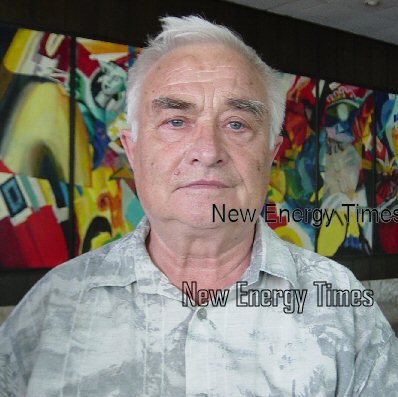
Alexander Ivanovitch Koldamasov
Photo: S.B. Krivit
|
|
This story first came to the attention of New Energy Times in June 2005 when we received rumors of a magnificent "breakthrough" and demonstration device. Indeed, a device was demonstrated, repeatedly, on-demand in Edmonton, Canada.
Witnesses to this device were several well-known researchers in the CMNS community: Martin Fleischmann, Robert Bass, Michael McKubre and Peter Hagelstein. Author Charles Beaudette and this writer were also present. However, hard evidence for nuclear reactions has not been reported to the scientific community. As well, no conclusive energy balance measurements have been performed that show a positive gain. The device was not a palladium-deuterium electrochemical device but rather a cavitation device that allegedly caused nuclear reactions to occur by means of a cavitation process.
|
Cavitation-induced low energy nuclear reactions are not new. Roger Stringham, among others, has worked on and reported such methods since 1989. On a trip to Russia in June 2007, New Energy Times was able to learn more about the origin of the concept behind the device. The idea behind the device appears to have come from Russian researcher Alexander Ivanovitch Koldamasov, who is retired from the Volgodonsk branch of the Russian National Research Institute of Atomic Engineering, in the town of Volgodonsk.
The working medium for this device was neither heavy or light water but machine oil. The researchers speculated that the hydrogen in the oil was the main source of the fuel for the device. The oil was not burned but allegedly consumed in a nuclear reaction process. The oil was circulated through the system at very high pressures and speeds and, at one point along the way, fed through several millimeter-sized orifices. Most of the observable anomalies occurred at the exit zone of these orifices, though one researcher (Vladimir Vystoskii of Kiev National Shevchenko University), working with a device at Moscow State University and later at Keldysh Research Center, reported evidence of an unusual glow emanating from the entry point of the orifices directed upstream, into the oncoming flow of oil.
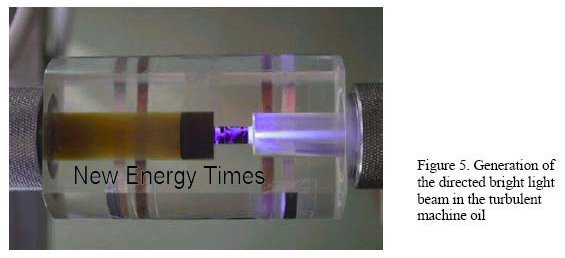
The cavitation device was brought to Edmonton, Canada, by Hyunik Yang, a Korean engineer who collaborated with the Russian researchers. Yang then partnered with Patrick Cochrane through Innovative Energy Solutions Inc. in an attempt to develop a Koldamasov-type device into a commercial product. The company ended up in bankruptcy, but several researchers continue independently to experiment with this method.
New Energy Times had called this a "hydraulic-electrostatic" device. "Cavitation" now seems to be a more suitable term. We also had called it the Koldamasov-Yang device. The intellectual primacy for the device now appears more accurately attributed to Koldamasov alone.
An abstract of a 1998 paper by Koldamasov, translated by Sergey A. Tsvetkov provides a concise technical description: "D2O electrolytic solution was contained in a glass tube with 1 mm diameter and 20-30 cm length. In the middle of the tube, there was a dielectric plate with a pinhole at the center. When supersonic wave with frequency 1-5 kHz was excited in the solution, neutron, gamma, 4He and heat were generated at the pinhole region with high reproducibility. The amount of excess heat reached 2000% of the input power. Energy and number of generated neutrons were 3 MeV and 40 /s cm2. Energy of gamma was 0.3 MeV." (A. Koldamasov, "Nuclear Fusion in Electric Charge," Proceedings of the 6th Russian Conference, 1998, Sochi, Russia, pp. 125-137)
Koldamasov attended the 13th International Conference on Condensed Matter Nuclear Science in Sochi, Russia, in the summer of 2007. The abstract, in English, for his presentation is included in the book of abstracts for the conference. New Energy Times also has made available his paper and the audio recording of his Sochi presentation.
Interview of Alexander Ivanovitch Koldamasov, June 27, 2007
English-Russian and Russian-English interpreting was performed by Elena G. Sergeeva
Steven Krivit: Can you tell me about the beginning of this line of research?
Alexander Koldamasov: I started to work with the phenomena in 1964 when I began my activity jointly with very famous Russian aerospace designer Nikolai Dmitriyevich Kuznetsov. He was an academician with the ex-USSR town of Kuibyshev; the present name is Samara. It was a special design bureau for rockets. He worked there with Sergei Pavlovich Korolev, a famous rocket designer. I was involved in the research with the first stage of the rockets. We were able to discover some specific things, some parameters that did not depend on pressure. We decided to look into the anomalies further. When we investigated this process, we made this cell.
SK: When was that?
AK: In 1964. When we began to do this activity, we discovered this special illumination which took place inside the cell. Immediately on discovering this phenomenon, we reported it to Korelov, and we got permission to continue this research. The task was established for us to make the fuel by itself, without additional efforts.
SK: I don't understand.
AK: Our given task was that the fuel should be burning by itself without adding any additional effort, without putting it in fire, without ignition. The idea was to just apply fuel and the rocket should start. And after some period of time, we got some results.
At that time in Russia, all patents and licenses for making discoveries were canceled. The procedure for obtaining patents or licenses to formalize discoveries was canceled during that period. That's why applications for getting authorization and certificates is named method for the presentation of liquid compunction, how to stabilize liquid compunction. Then we made the big calculation and got results and the method of using ignition from a spark.
The concept of a small portable energy source was of interest to us. We had taken into consideration of building spaceships to save each gram of metal to make their construction lighter weight. That's why this method was thought to be very practical.
SK: Can you translate this certificate? [Krivit points to document listing Koldamasov's certificates.]
[Interpreter: "Methods how to stabilize liquid compunction."]
AK: In the ex-Soviet system, we couldn't get patents. We got certificates, instead. I have four certificates. The first one was issued during the ex-Soviet Union time. The others are more recent. They are patents for a nuclear reactor. This is another patent. In order to receive electrical current, we put a magnet outside the cell.
SK: Did you ever perform energy balance measurements?
AK: In comparing the input with the output, the difference was 20x; 1 kW in, 20 kW out. If we put an inductive magnet, we did not get continuous power. If we used a permanent magnet, we did get continuous power. Then we got a patent for a method for a hydrogen-creating device. In this work, Mrs. Kornilova takes part.
SK: And Hyunik Yang? He takes part, as well?
AK: Only Mrs. Kornilova. We applied for three more applications for methods and devices, but it is not yet time to disclose that information. When we get the patent, we can discuss that openly.
SK: Can you tell me more of the details of how you first observed the phenomena?
AK: We prepared a transparency material, a special sheet, and it began to glow.
SK: Is there any other phenomenon you know that produces this kind of glow?
AK: Yes, the glow is there, but cold fusion is not there yet; just glow.
SK: I don't understand.
AK: We began to observe glow, but at this stage we didn't have the cold fusion process. We had to increase the pressure to higher than 100 atm.
[Krivit shows him slides from Vysotskii's ICCF-12 presentation]
AK: Yes, we have this discharge. A special electromagnetic wave is created in drops. Some cloud consisting of drops has been created.
SK: Are you describing cavitation?
AK: Yes, that's correct.
SK: What are your thoughts with regard to a practical application or device?
AK: It can have practical application from this moment, we think. We made some experiments using kerosene, machine oil and both heavy and light water.
SK: Who do you work with now?
AK: Vladimir Vystoskii and Kornilova at Moscow State University. I'm 74 and am actually retired. I don't work anymore.
AK: If I perform the experiment with kerosene or oil, it generates gamma radiation. If I work with light and heavy water, there is no gamma.
SK: How does the heat compare?
AK: [Unclear response]
SK: How about neutrons?
AK: It's possible to put protection for neutrons with the heavy and light water experiments. But it's much harder to make the protection for gamma.
SK: So you are retired. Now who is continuing the work?
AK: Kornilova at MSU and Baranov at the [redacted]. And installations were sold to South Korea and to Canada.
SK: Were they installations or just designs?
AK: We designed and created the installations.
SK: Who did the design? Yang?
AK: Kornilova.
SK: She and Vystoskii designed them?
AK: Actually, they took information from Baranov, and Baranov [took] the information from me, so this process is going on.
SK: What about the Canadians?
AK: The Canadians, same situation.
SK: Which situation?
AK: The same people stole the information. They sold it.
SK: They sold it or stole it?
AK: They stole information and sold the installation!
SK: What was sold, and what was stolen?
AK: These schemes are more or less known.
SK: Is this public knowledge?
AK: Yes. I don't have any claims for that because it is published. I am the owner of the patent.
SK: So what part was stolen?
AK: The schemes and metals.
SK: Does that mean designs?
AK: Yes, designs.
SK: Are you a collaborator with Baranov?
AK: We know each other. Are you from the U.S.?
SK: Yes.
AK: Well, you can do the same now, if you like.
SK: Steal your designs?
AK: Yes. One British man approached me, and they also wanted to take the idea and create an installation for themselves. Nothing is given to me; nobody gives me the credit.
SK: Yang says this is the Koldamasov-Yang method ...
AK: Yang actually bought the installation from Mrs. Kornilova.
SK: What did you get?
AK: I got nothing. I grew up in the Soviet Union time period, and scientists were not taught how to make money.
SK: I have seen a patent that has your name as inventor but not as owner. What is that about?
AK: I had a joint patent with Mrs. Kornilova for producing hydrogen.
SK: Did anybody give you ...
AK: The term of validity of patents will expire soon, which means anybody can begin to use them without even asking.
SK: The Russian patents?
AK: Yes.
SK: Would you like people to use this technology?
AK: Of course, being an author of this method, certainly.
Baranov Replication

Close-up photo of Baranov Cell from ICCF-13 paper
Dmitri Baranov may have been the first person to replicate the Koldamasov cavitation device. New Energy Times interviewed Baranov on June 27, 2007, in Sochi, Russia. He was reluctant to talk; he did not want to go on record as a representative of his institution.
"My work is underground,” he said. “It's not official; it's just my hobby."
He said he first met Koldamasov around 1994 or 1995. Baranov stated that his director sent him to Volgodonsk to get information about Koldamasov's work so Baranov could replicate it.
Baranov was difficult to understand, but apparently he improved on the Koldamasov device by introducing transformer or machine oil to the system, replacing the light or heavy water that Koldamasov had used. An immense effort is required to purify water to exhibit the required dielectric characteristic. Baranov said oil had several advantages: a stronger dielectric property, higher viscosity and a much simpler high-pressure pump than is required for a water system.
Lineage of Koldamasov Machine
The most accurate progression of the events relating to the Koldamasov device that New Energy Times has is the following: In 1964, Koldamasov says he began his work on this device, using water but apparently not oil. Baranov says he visited Koldamasov in 1994 or 1995 and replicated the experiment but with oil instead of water. At some point Peter Mobberley of Advanced Energy Technologies in the U.K. learned about the device and started his own replication attempts as well.
Alla Kornilova (Moscow State University) said that she and Vladimir Vystoskii (Kiev National Shevchenko University) first met Yang in 2001 on an unrelated matter having to do with hyaluronic acid (used in biotechnology). According to abstracts, in 2002, researchers S.M. Godin, L.B. Polyakov and V.V. Roschin reported “Electric, Magnetic & Radiation Effects Research in Modificated Koldamasov Cell” at the 10th Russian Conference on Cold Nuclear Transmutations of Chemical Elements and Ball-Lightning.
Kornilova stated that, in 2002, Yang sponsored the trips for herself, Koldamasov and Vysotskii to attend the 9th International Conference on Cold Fusion in Beijing, China, and they collaborated there. At some point Yang made an agreement with Patrick Cochrane of Innovative Energy Solutions Inc., apparently representing the Russian researchers. On Dec. 1, 2005, Yang informed New Energy Times that he was no longer working with Innovative Energy Solutions Inc.; instead, he was working with Fusion Research Corp. In 2007, Kornilova stated that she and Vysotskii were no longer business partners with Yang.
|
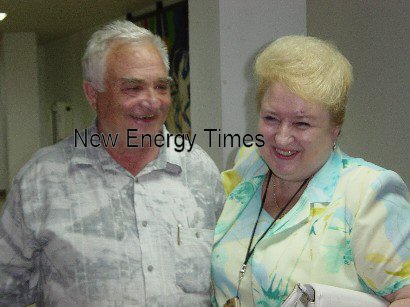
Alexander Ivanovitch Koldamasov and Alla Kornilova
Photo: S.B. Krivit
|
|
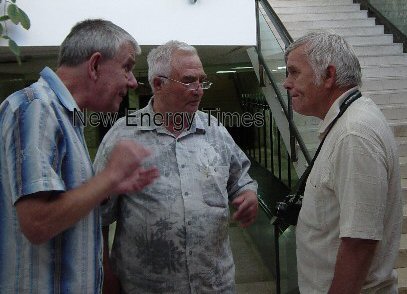
Peter Mobberley, Alexander Koldamasov and
Dmitri Baranov talking shop
Photo: S.B. Krivit
|
__________________________________________________________________________________
19. Excerpts of Student Paper: Report on the Work of A.I. Koldamasov
"Research and Development in the Field of Low-Temperature Plasma Physics for Cold Fusion Based on Cavitational Emission of Electrons."
By Anna Alexandrovna Alimuhambetova, Volgodonsk University
Translation by Peter Gluck
[The following text is a translation of some of the text from this student paper pertaining to the cavitation work of Alexander Ivanovici Koldamasov. The paper was written in 2005 as an entry in the all-Russia competition "Energy of the Future," sponsored by the Federal Agency on Atomic Energy, Nuclear Society of Russia, Volgodonsk Branch. The full paper, in Russian, with photos and diagrams is here.]
In the year 1972, A.I. Koldamasov, an engineer from the town Kuibyshev (today called Samara, Russia) has published a paper [43] (it is about "ball lightning in liquids") in which he related about the observation of a bright discharge formed when distilled water (with a high specific resistance - greater that 10E11 ohm-m) is forced to flow through cylindrical holes of 2 mm diameter and length of 25-30 mm, made in a plate of organic glass (poly-methylmethacrylate) or other dielectric material, positioned coaxially in a tube to which it is fed water with a gear pump, up to a pressure of 7MPa.
The glow discharge appeared when at the input edge of the hole made in the dielectric material started an intense hydrodynamic cavitation that has triggered strong resonating pulsations of the water column in the tube between the gear pump and the dielectric plate, with a frequency of 5kHz. Pulsations were induced to the water column by the pump in that each pair of gears, closing down, created a shock. The experimenter had to choose the speed of rotations of the gears for which the frequency of the shocks became equal to the specific pulsation of water in the column.
The glow came from a ring of plasma formation at the input edge of the hole. The color of the glow depends on the material of the dielectric plate: for ebonite: yellow, for organic glass: orange, for asbo-cement: green. Pyrometric measurements have shown that the temperature of the plasma attains 10E4 K, and the energy contained is 10E4 J/cm E3. It could be stated that the glow is associated with Rontgen radiation that is dangerous for life. The intensity of the dose at a distance of 10-15 cm was up to 0.85 mR/s and the energy of the quanta 0.3 MeV. After 100 hours of functioning, during that the observed glow was more or less intense, the surface of the organic glass at the input edge of the limiting hole changed color, however no sign of erosion could be observed.
In case if Koldamasov could then guess that he has to measure also the level of neutron radiation coming from this "ball lightning in water" as he then called this formation of plasma, then he could possibly receive the laurels of Fleischmann and Pons. However he has performed such measurements, described in [44] only in 1989 after the publication regarding the discovery of cold fusion. The density the flux of neutrons for the Koldamasov experiment with the addition of 1% heavy water, at a distance of 10-15 cm from the source is up to 35 sqcm/s.
In the Koldamasov experiments a stabile flux of neutrons is obtained with a global intensity reported to the complete sphere of 10E3/second. Other people even do not dare to dream about such high results. The author has published results only for the local flux not the global value.
The measurements of Koldamasov have shown that in the area of glow discharge, at the surface of the dielectric material, positive charges are concentrated, while in the "corona" surrounding it, while in the direction of the flux of water- negative charges. The potential of the dielectric material relative to the earth is increasing with the increase of cavitation, and attains +300kV for a cavitation number >4. During this the current of electrization stream has increased leapwise from 0.01 microAmperes to 0.1 micoamperes for the cavitation number 1.75 and further linearly with the increase of the potential. An even greater influence on the yield of Roentgen and neutron radiation has the purity of water- if its specific resistance is the electric current is also increasing.
During the initial period of his research Koldamasov has supposed that the observed glow is due to sonoluminescence, but later it became obvious that sono luminescence was observed only inside the liquid cavitating in the throttling channel and has a completely different behavior than the glowing plasma cloud. He has observed sonoluminescence even then when the negative potential accumulated on the metallic isolated pipe leading to the throttling plate was not linked to the earth via the microampermeter and when the glow of the plasma formation was extinguished and the Roentgen and neutron radiation has also disappeared. This means that in this case sonoluminescence is not linked to cold fusion if this takes place during these experiments. The merit of Koldamasov is also bound to that he was able to show that not the metallic details exposed to cavitation in water are causing cold fusion, but something else.
At the X-th International Symposium: "Revision of Natural Sciences" (Volgodonsk, Russia, April 1999) [45] the inventor has presented his hypothesis regarding the nuclear processes that take place in his device during the experiments described above. He came to the conclusion that the deuterons in all the processes of cold fusion are not overcoming the Coulomb barrier but are coming near one to other due to electro-neutrality.
A.I. Koldamasov starts from the known theory of the exchange interactions between the nucleons in the deuteron, realized via the virtual negatively charged mesons. When such a meson generating a neutron after some time in the nucleus of the atom is transformed in a proton, is flying to an other (real) proton in the deuteron, where the distance between the nucleons is significant (because the radius deuteron is 6 times greater than the radius of the nucleon) then for some time it is placed between two positively charged protons. And as the positively charged foils of the electroscope are not more repelling each other when between them it is a negatively charged foil and start to be attracted by it, in the same way the negative charge of the meson in the deuteron is neutralizing the interaction of the positively charged protons in the deuteron. Further the neutral deuteron can interact nuclearly with the nuclei of any atoms from the periodic system of Mendeleev. For this reason, in his opinion, the atomic mass of each element of the periodic system, usually differs from the mass of its neighbor by the mass of two nucleons.
In order that the deuterons should come near to each other and enter the reaction of cold fusion it is necessary first to ionize the atoms of deuterium and then accelerate the positive ions (deuterons) to a sufficiently high speed. All these are accomplished, according to the inventor, in the electric field of high tension formed due to the charging of the surface of the dielectric plate with positive charges. He thinks that the atoms of deuterium from water under the influence of the positive charge of the edge of the hole are losing their electrons. Thus formed positive ions of deuterium in the same field of the edge are accelerated in water and get the kinetic energy necessary for the bombardment of other nuclei of deuterium and entering nuclear interaction without overcoming the Coulomb barrier.
Conclusions
1. The cavitational sonoluminescence in a flux with no generator of ultrasound usually has light-hydrodynamic COP (coefficient of performance) with 5 orders of magnitude smaller than the COP of ultrasound cavitation. The balance of energies for sonoluminescence and a careful calorimetry have not been performed for the previous works. It cannot be excluded that the global yield of heat and light energy is greater than the expended sonic or hydrodynamic energy.
2. In the conditions of non-equilibrium of the shocking waves, it takes place the concentration of the elastic energy of the sonic field in separate molecular associates of water and this leads to their dissociation in radicals, that is necessary for sonoluminescence.
3. In the works of B.V. Deriagin and collaborators during the 1990's it was observed that the ultrasound cavitation in heavy water on a titanium vibrator leads to a weak and sporadic emission of neutrons. The combination of ultrasound and electrolysis leads to a stabilization of the process and gives an emission of neutrons that is 10 times greater that the background level. In the same time the yield of tritium is 10E7 times greater than the yield of neutrons and the nuclear reactions are continuing 10 minutes after the stopping of the ultrasound. An acceptable explanation of the dominant formation of tritium was still not found until now.
4. In 1972, Koldamasov has observed a bright glow (with a temperature of the plasma of 10E4 K) from the input edge of the hole made in a dielectric material placed in a pipe where water is fed, at resonance cavitational pulsations. At the dielectric plate it is formed a positive potential up to 300 kV, while the flux of water carries negative charges. The glow is associated with intense Roentgen radiation, and in the case of using of heavy water also an emission of neutrons at an intensity of 10E3/second for many hours of work.
5. It can be supposed that the glow in the Koldamasov experiments is caused by the sonoelectroluminescence in the toroidal cavity formed by the vortexing water at the edge of the orifice. The electric field due to the accumulated charges is intensified due to the difference in the electrical permeability for the cavity and water, and this leads to the accumulation of energy in the cavity. In conditions of non-equilibrium, nuclear reactions can start in the cavity.
6. It is supposed that when the electron layer of the atom of deuterium is tunneling through the nuclei of atoms, then for a given time the nuclei (deuterons) are in a state of electro-neutrality and there is not necessary to avoid the Coulomb barrier for coming in the vicinity of a proton or an other deuteron. Such three-body collisions of deuteron, electron and proton are leading to a new class of nuclear reactions, in that the electron plays the role of catalyst that increases the probability of nuclear reactions, and, especially it is increased the yield of the reaction of formation of helium-3 with no emission of neutrons and the reaction of formation of tritium. This explains the observations regarding cold fusion- that the yield of tritium is higher than the yield in electrons -- that was still now an enigma.
__________________________________________________________________________________
20. Proton-21 Research Presented in University of Illinois Seminar
by Thomas Dolan
On Feb. 26, Dr. Lev B. Malinovskyi presented a seminar on “Controlled Nucleosynthesis” at the University of Illinois, based on research at the Electrodynamics Laboratory Proton-21, headed by Dr. Stanislav Adamenko, Kiev, Ukraine. The laboratory began in 1998. Since 2000, they have been conducting studies of nuclear reactions stimulated by injection of a focused high-voltage electron beam into the hemispherical tip of a thin target rod. The Proton-21 group is studying ways to use the technology for power generation, for materials modification, and for remediation of radioactive wastes. The following data are from the seminar and from the article cited in Reference 1.
Early targets were 0.5 mm diameter high-purity Cu, Ag, Ta, or Pb. The electron beam had up to 500 keV energy, 50 kA current, lasting 30 ns, with beam energy up to 2.5 kJ. The researchers observed that the tip peeled away like the peels of a banana and left a conical crater in the rod. (See Figure 1 below).
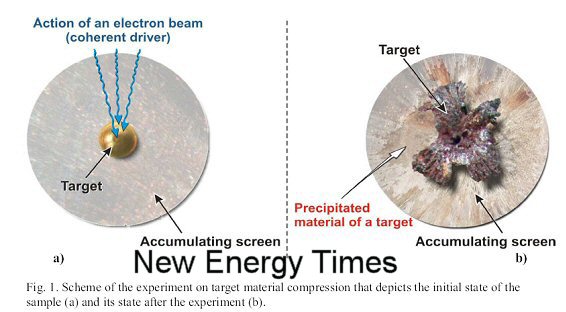
They studied optical emissions, particle emissions, x-rays, and transmutations of target elements. They have done 15,000 experiments.
The optical measurements with a resolution < 1 nm were fit with a computer program to identify elements and intensities. The data indicated about 8x1017 ions with energies ~ 9.5 keV (from Doppler broadening), total energy 0.75 kJ, and 1018 electrons with Te ~ 0.36 keV, energy 60 J. They also found spectral lines of elements not in the original target.
Fast ions were measured with CR-39 track detectors and with time-of-flight magnetic analyzers. The magnetic analyzers measured plasma ions with energies ~ 20 keV/nucleon. The track detectors found evidence for clusters of alpha particles with energies of 4-6 MeV. With 300 J input, the yield of exploded material energy is up to 10 kJ.
About 1015 x-ray photons with a peak energy ~ 35 keV are emitted from the source region (diameter < 200 mm) in 10 ns. The x-ray and gamma ray spectra from the target are similar to those from quasars, gamma-bursts, and pulsars (See Figure 12 below) but not with those from supernova CH1987A or the sun.
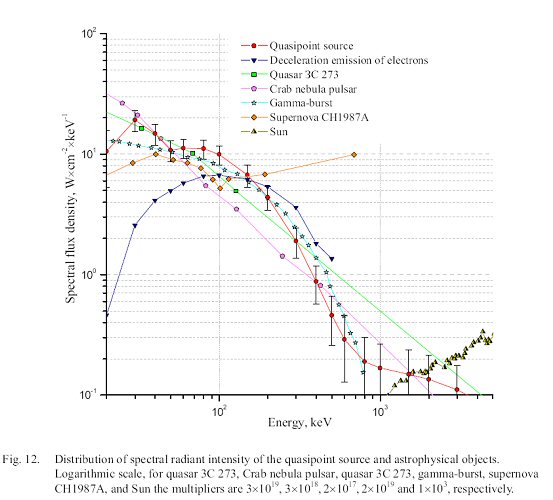
They studied the reaction products with several methods. X-ray electron probe microanalysis in various locations after compression of an initially pure (99.99%) Cu target revealed synthesis of elements Zn, K, Mg, and Au in significant quantities. (See Figure 20 below.)
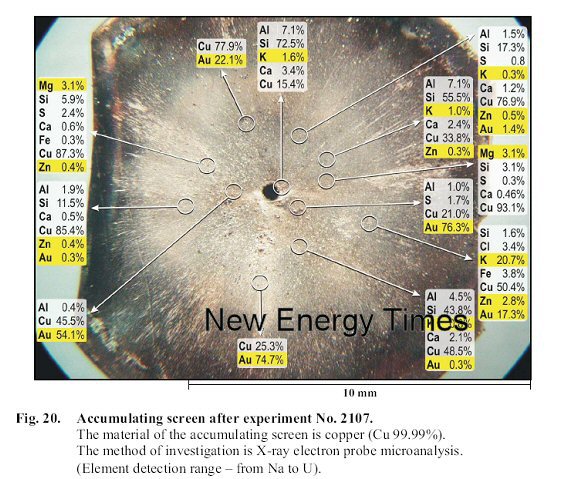
Gold (197.0 amu) is much heavier than copper (63.5 amu). From analysis of a screen that collects emitted atoms, they estimate that about 1015-1016 atoms were synthesized per shot with a 300 Joule electron beam incident onto the targets. The synthesized atoms are stable, emitting very little radiation.
Mass spectrometric measurements of the material deposited on the screen showed anomalous isotope ratios for several elements. For example, the ratio of 57Fe/56Fe was increased from the normal value of 2.4% up to 12% at the surface of one sample, decreasing to the normal value at a depth of 15 mm. Isotope ratio shifts were also shown in Si, Ca, Ni, Cu, Hf, Zr, and Zn.
In other experiments, radioactive 60Co was compressed, and the resulting radioactivity was reduced by 2% to 48% in various samples. From experimental data, they calculate that about 2.5x1018 radioactive nuclei in the focal zone are transmuted per 300 Joule of beam energy incident.
In experiments with heavy targets (Pt, Pb, Bi), they found evidence for formation of superheavy elements with masses over 400 amu.
They conclude that impact-induced compression could initiate collective, multiparticle nuclear reactions in the target material, as evidenced by the formation of elements more than twice the mass of the target element. The dense sea of electrons reduces the Coulomb barrier between positive ions, facilitating their close approach and nuclear interactions.
Malinovskyi said that Proton-21 scientists presented these results at a seminar in Bonn, Germany, in 2004; and he stated that, since then, they have had collaborations with many European laboratories, which rechecked their experiments, measured the reaction products and verified their results.
Proton-21 is studying ways to use their nucleosynthesis technology for power generation, for materials modification, and for remediation of radioactive wastes. They have applied for or received patents in Europe, the USA, Japan, and elsewhere. Their new accelerator can provide 80 kJ of beam energy at up to 1.5 MeV, 0.5 MA, in 100 ns into a target with diameter ≤ 5 mm.
More information is available in the new book Controlled Nucleosynthesis (Ref. 2).
References:
1. Proton-21, “Results of experiments on collective nuclear reactions in superdense substance” (Kyiv, Urkaine, 2004) http://www.proton21.com.ua/articles/Booklet_en.pdf
2. Stanislav Adamenko, Franco Selleri, Alwyn van der Merwe, Editors, Controlled Nucleosynthesis, Breakthroughs in Experiment and Theory, Springer Verlag, Dordrecht, The Netherlands, 2007
__________________________________________________________________________________
21. PUBLICATIONS
Hagelstein-Chaudhary Critique — January 24, 2008
"Electron Mass Shift in Nonthermal Systems" Preprint (pdf)
Peter Hagelstein and Irfan Chaudhary of MIT have written a paper that directly challenges Widom and Larsen's 5th paper. According to Hagelstein and Chaudhary, their intuitions and calculations show that MeV-scale energy, as proposed by Widom and Larsen, is highly unlikely.
Rebuttal to Hagelstein and Chaudhary Critique — February 5, 2008
"Errors in the Quantum Electrodynamic Mass Analysis of Hagelstein and Chaudhary" Preprint (pdf)
Widom et al. critique Hagelstein and Chaudhary for making out-of-context references with regard to Widom et al.'s electron mass renormalization in exploding wire systems and also for making erroneous calculations that conflict with the Gauss law. Widom et al. also state that Hagelstein and Chaudhary selectively ignored substantial factors relating to Ampere interactions. Widom et al. rebuke Hagelstein and Chaudhary for their "fallacious considerations" and provide arguments to show that their previous calculations remain valid.
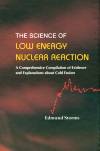 The Science of Low Energy Nuclear Reaction: A Comprehensive Compilation of Evidence and Explanations About Cold Fusion, by Edmund Storms. Singapore: World Scientific Publishing Co., 2007. 312
pp. $71.OO (hardcover) ISBN-13978-981-270-620-1. The Science of Low Energy Nuclear Reaction: A Comprehensive Compilation of Evidence and Explanations About Cold Fusion, by Edmund Storms. Singapore: World Scientific Publishing Co., 2007. 312
pp. $71.OO (hardcover) ISBN-13978-981-270-620-1.
Review of Edmund Storms' Book by Dieter Britz
(Reprinted from the Journal of Scientific Exploration, Vol. 21, No.4 p. 801, Winter 2007)
"Cold fusion" refers here to the claim that, by simple electrolysis of heavy water with some electrolyte, the deuterium ions (deuterons) that accumulate inside palladium or some other metal can be made to fuse. This surprising claim was made by Fleischmann, Pons and Hawkins (1989) and, almost concurrently, by Jones et al. (1989). Much has been said about this subject, which has become a scientific "affair" of sorts, with most mainstream scientists refusing to accept the reality of cold fusion and a smallish band of researchers continuing work and indeed publishing their findings. The present author began to collect a bibliography (hereafter, the Bibliography) of the literature in 1989 (see http://www.chem.au.dk/~db/fusion), including only papers in refereed journals, and the present count is 1,367. As many as 30 books have been published on the subject. Of these, not all are notable, some being hasty productions or having clear weaknesses, but some stand out. Some of these were written by proponents of the phenomenon and some by skeptics. Most of the books were written by people who have not themselves worked on the phenomenon, some being science journalists or enthusiasts without a scientific background.
Two books written by adherents of cold fusion stand out in that they were written by people who are active in "normal" science, with solid research records, and who themselves have done research on cold fusion. One of them was by Toru Mizuno (1997), an electrochemist, and the other by radiochemist Edmund Storms, whose book is the subject of this review. The claim of cold fusion is astonishing to anyone with a smattering of knowledge of physics. The fusion of deuterons is resisted strongly by electrostatic forces keeping these positively charged particles apart. Fusion can be achieved by heating plasma (hot fusion), and theoretical studies of the expected rate of fusion at low temperatures, as obtained in an electrochemical cell, predict rates so low that nothing will be detected. There are, then, good reasons for being skeptical of cold fusion claims. A book such as this one, however, makes a strong case for cold fusion, not only by the results presented but also by the impression the reader gets of the writer.
Storms is a working scientist, and this shows clearly in the book. He begins with a clear statement that he is convinced of the reality of cold fusion (preferring to call it low energy nuclear reaction). He is not, like some proponents of the phenomenon, oblivious to the weaknesses of many claims; that is, he shows the proper critical attitude of a normal scientist and (mostly) does not accept unsound evidence. Much shoddy work has been done in the field, but other than this, some evidence remains that leaves the skeptic in a quandary; the phenomenon is unlikely to be real for many reasons, but there is much evidence nevertheless that it may be real. Storms does his best to point out such evidence based on his own work. The book contains an interesting account of his own work, and to a practicing scientist, he conveys a true picture of science as it is done: It rings true to someone who is a working scientist.
The book is divided into 10 chapters and six appendices. It begins with an overview, a brief history of the field and (Chapter 3) a description of Storms' own work. The book's strength lies here, and the scientific reader will feel at home. Chapter 4 outlines what is known or believed; Chapters 5 and 6 focus on where cold fusion might occur and how perhaps to affect or even initiate it by means of experimental parameters. Chapter 7 considers fusion products and their detection, and, in the last chapters, Storms looks at some theories, the future of the field, and, in Chapter 10, a brief summary. Each chapter has its own bibliography, with Chapter 4 having a massive 646 citations.
The claims by Fleischmann, Pons, and Hawkins and of Jones et al. immediately engendered an embittered controversy between the "believers" and the "skeptics," with arguments and evidence not always strong on either side. In general, one should be wary of blank pronouncements by scientists that something is impossible, and as Storms points out, although there is no good theory of cold fusion, the experimental evidence is not easy to dismiss (in his view, it proves the phenomenon real beyond doubt). As mentioned above, the bibliography has 1,300 entries. Compared with other fields that appeared around the same time, such as high temperature superconductivity, however, this is not a large number. The bibliography also shows that the publishing rate rose sharply initially but fell exponentially thereafter, similar to the polywater affair (Franks, 1981), a curve that has been likened to the course of an epidemic (Bennion & Neuton, 1976). Many journal editors flatly refused papers on cold fusion, and some referees probably rejected papers not so much on the basis of the evidence presented as on the basis that cold fusion simply must be entirely an error. Many cold fusion papers submitted (and published) have been of poor quality and deserved to be rejected. Storms agrees with this. The result has been that, in recent years, although some work is appearing in mainstream serious journals, most work appears in enthusiast journals, where refereeing probably is not very strict. If these articles were counted (which they are not in the bibliography), then several thousand papers have been published. Storms himself has published some of his work in these journals, no doubt tired of unfair rejections by the normal journals.
When two deuterons fuse (against a strong electrostatic barrier), the reaction can proceed along three branches, two of them the most probable. One branch leads to tritium and a proton, the other to helium-3 and a neutron, and the third branch, normally occurring with a frequency of only 10^-7 that of the other two, to helium-4 and highly energetic gamma emission. In all cases, the result is particles carrying extra energy corresponding to lost mass to be dissipated in various ways. This all happens in "normal"—that is, hot—fusion. Skeptics argue that all emissions must be present, and proponents point to one or two of them as proof, or they say that the process may not be the fusion of deuterons but some "hitherto unknown nuclear process" (Fleischmann Pons, & Hawkins, 1989). They insist that experimental observations are paramount and that the lack of theory will be made up later. Storms takes this view, hence his use of "LENR."
Storms' own work concentrates on tritium production and "excess heat." Storms was ideally placed at the Los Alamos National Laboratory to detect tritium. When a solution of an electrolyte in heavy water is electrolyzed at length, deuterium gas is given off with some tritium, contained as an impurity in the heavy water (and perhaps also in the palladium). Storms is careful to account for these sources. His findings are interesting: Excess tritium appears first in the electrolyte, not in the effluent gas, indicating that it is produced at the palladium electrode. Storms was careful to perform control experiments aimed at eliminating environmental effects (at Los Alamos, tritium might occasionally be in the air) and convincingly shows that they were indeed accounted for. Similar results were obtained by Will, Cedzynska & Linton (1993), equally competently obtained, and the skeptic is hard put to reject these results.
Excess heat is measured with a calorimeter. Current is passing through an electrochemical cell, with a voltage across it, producing an input power, and the electrolysis reaction absorbs some of this power at a well-known rate. Effluent deuterium and oxygen might carry off some heat, and heat is both radiated and conducted away from the cell. To keep track of all this is not trivial, and Storms became expert in calorimetry over the course of years, as problems were found, some of them by skeptics and addressed by him, carefully doing control experiments to assess the magnitude of interference effects. One of them is the way the temperature inside the cell is measured. Temperature gradients may be inside the cell, and this problem can be overcome by a better calorimeter design, which Storms created. If in the accounting of the known input and the measured output powers an excess occurs, this indicates the presence of some phenomenon producing heat. One problem is the irreproducibility of the effect; only some electrodes show it and not all the time. This is one of the strong points that skeptics make. A new effect must be reproduced by others, and this has not been done to the skeptics' satisfaction, even after 20 years. Reproducibility can be achieved, however, only when we understand all the factors at work, which is not the case here, so irreproducibility itself does not invalidate cold fusion. Needless to say, Storms tried many different variables: various sources of the palladium, how best to vary current with time, how best to load the palladium with deuterium, which loading degrees are needed, and surface treatment of the metal before the experiment. The results do not give a very clear picture.
The book makes a good case for cold fusion. There are some weaknesses. Some of the figures are poorly done, and the text is often awkward. Some expert criticism of Storms' calorimetry (Shanahan, 2006) is not mentioned, and there is some imbalance in attribution: To some extent, the work by Jones' team is de-emphasized in favor of that of Fleischmann and Pons' team. Storms is not especially good with foreign names, mangling some of them, and Kirk Shanahan, one of his staunch critics, appears as "Kurt Shanahan" in the index. Storms suggests the fusion of up to six neutrons with some nuclei, which will surprise many. The term "enthusiast" applies to Storms. The word "amazing" is seen six times in the book, and his critical attitude does seem to lapse at times. For example, he appears to accept what has been called "biological fusion" (Kervran, 1972), which is even less likely to be real than cold fusion, and he even suggests that it might be behind spontaneous human combustion. He also accepts claims by Mills & Kneizys (1991) of electron orbitals of the hydrogen (or deuterium) atom below the ground level, although here Storms appears to be a little skeptical, admitting that there is a lack of theory (which can be said equally well of cold fusion). In Chapter 9, he writes "the skeptics went to war—a war they have now lost." In the preface, he writes that cold fusion has now been proved. Many would disagree and remain unconvinced. So the book is not neutral on the subject. Nevertheless, these weaknesses are comparatively minor and do not detract from the major message of the book, the rather solid experimental evidence of some exotic process taking place, from a careful and self-critical researcher.
What is the bottom line? This writer remains agnostic with respect to cold fusion because even a thorough worker like Storms has not succeeded in demonstrating the effect at will. This is not to say that we can dismiss cold fusion but simply that we must wait for evidence so convincing that even skeptics must accept it as real. If it indeed is real, then it is subject to parameters that elude most workers in the field. Other newly discovered phenomena have been irreproducible for some time (albeit rarely for 18 years, as here), and this alone does not prove it to be false. We shall have to wait and see. The Storms book certainly is recommended reading, for both skeptics and proponents.
DIETER BRITZ
Chemistry Dept.
University of Aarhus
Aarhus, Denmark
britz@chem.au.dk
References
Bennion, B. C., and Neuton, L. A., "The epidemiology of research on 'anomalous water,'" Journal of the American Society of information Science, 27, 53, (1976)
Fleischman, M., Pons, S., and Hawkins, M., "Electrochemically Induced Nuclear Fusion of Deuterium," Journal of Electronalytical Chemistry, 263, 308, (1989) Erratum, ibid, 263, 187, (1989)
Franks, F., "Polywater." MIT Press, (1981)
Jones, S. E., Palmer, E. P., Czirr, J. B., Decker, D. L., Jensen, G. L., Thorne, J. M., Taylor, S. F., and Rafelski, J., "Observation of Cold Nuclear Fusion in Condensed Matter," Nature, 338, 737, (1989)
Kervran, L., "Biological Transmutations," Brooklyn, NY: Swan House Publishing Co. (Collected and translated from the French by Abehsera, M.) (1972)
Mills, R. L., and Kneizys, S. P., "Excess Heat Production by the Electrolysis of an Aqueous Potassium Carbonate Electrolyte and the Implications for Cold Fusion." Fusion Technology, 20, 65, (1991)
Mizuno T., "Nuclear Transformation: The Reality of Cold Fusion," Concord, NH: Infinite Energy Press; translated by Rothwell, J., from the Japanese edition, Kogakusha Publ. (1997), (1998)
Shanahan, K. L., "Reply to Storms, E., 'Comments on Papers by K. Shanahan That Propose to Explain Anomalous Heat Generated by Cold Fusion,' Thermochim. Acta, 2006," Thermochimica Acta, 441, 210, (2006)
Will, F. G., Cedzynska, K., and Linton, D. C., "Reproducible Tritium Generation in Electrochemical Cells Employing Palladium Cathodes with High Deuterium Loading," Journal of Electroanalytical Chemistry, 360, 161, (1993)
Review of Edmund Storms' Book by Scott Chubb
(originally published in Infinite Energy, Issue 77, Jan/Feb 2008)
It is Christmas Eve. And what a gift it has been to me to read Edmund Storms’ new book, The Science of Low Energy Nuclear Reaction: A Comprehensive Compilation of Evidence and Explanations about Cold Fusion, and to be given the opportunity to review it for Infinite Energy. It is both a pleasure and a privilege to recommend this book. Not only does it provide important, historic information about an incredibly important, new area of science, but it does this in a way that provides an important context for understanding the remarkably complicated set of circumstances that has led to such confusion about the area. In particular, when “cold fusion” burst onto the scene in 1989, very little was understood about the relevant experiments, and incredible confusion resulted as a consequence. Edmund Storms provides a scholarly, well-thought-out exposition that explains both the context and the confusion about it, and the relevant science. In doing this, he has performed an invaluable service not only by providing a very real, human perspective about the associated events but by explaining many of the more subtle points that have not been obvious, even to experts of the field.
This book provides a remarkable story about a remarkable period in science. As Michael McKubre notes in the first Foreword, the book “is a well-written, easily readable account of the birth and early childhood of a field whose limits and applications have not yet been revealed.” The book also provides an important perspective associated with the events and science that many in the field share, involving an open-mindedness and dedication that has been missing in most discussions of the subject by individuals who are not familiar with the relevant science.
Pons and Fleischmann (PF) claimed that they had achieved release of nuclear fusion energy by using the electrolysis of heavy water to deposit deuterium onto a palladium metal cathode. These claims would have been ignored if PF had not been recognized authorities. Fleischmann was a Fellow of the Royal Society in England and Pons was the chairman of the chemistry department at the University of Utah. Both had extensive publications. When PF announced their discovery of cold fusion, Ed Storms was working as a material scientist in a space nuclear propulsion program at Los Alamos National Laboratory. Plans for duplicating the PF experiments began the next day, and Ed joined the effort shortly after the initial work began. His book starts with those formative days of cold fusion. He writes with the authenticity that only an active participant can provide. The book, clearly, provides a seminal recounting of past events and, for this reason, is destined to become a primary source of information for future historians.
The first weeks following the March 23 announcement were a period of intense excitement throughout the chemistry and physics worlds. Though almost nobody really thought that nuclear reactions could be carried out using normal chemistry, the claims had to be checked. This looked deceptively simple to do. Rapid testing followed. But there were only a few apparent successes, and most attempts failed. A tide of ridicule followed. As Storms tells the story, a climax occurred at the May 1, 1989 meeting of the American Physical Society, in Baltimore. “Major damage was done to the field by the hubris and misdirected self-confidence of a few people. Thus, a myth was created that even today continues to have a negative impact.” For one thing, a proper repeat of the PF tests takes far more time than had passed since the announcement. A stranglehold of inappropriate theory, based largely on the false assumption that cold fusion had to be a form of hot fusion, evolved, in which implicitly it was assumed that neutrons and high energy particles had to be released. The book provides an invaluable description of these early events that both explains the associated controversy and provides a human perspective associated with what took place.
Ed’s laboratory studies on cold fusion began almost immediately after the announcement. Storms joined a new laboratory test program. Working with Carol Talcott, he and she ran more than 250 electrolysis experiments, in which their primary goal was to detect tritium. Tritium was an expected product of any then-known fusion reaction. Most of the runs showed no tritium, but a few showed larger amounts than could be explained as contamination. When reaction tritium was found, it was found in the electrolyte and was not present in gas that is liberated by electrolysis. Roughly 50 years earlier, Farkas had shown that the gas in bubbles formed on palladium during electrolysis originates in microcracks, which receive interior deuterium. Therefore, tritium entering the water by reversible chemistry had to come from reactions occurring on or near the metal surface. Ed and Carol published their results in 1990. The studies convinced Ed that something nuclear sometimes occurred. Ed’s work with Carol had an additional impact: They decided to get married, and Ed began a new career as a continuing researcher in a developing, international cold fusion program. Ed and Carol built a unique and beautiful home, not far from the Sante Fe Institute, and a very enviable home laboratory where Ed continues to conduct his research experiments.
Ed’s home lab studies have reinforced his conclusion that long electrolysis onto bulk metal can produce a nuclear active environment on or near the surface of his metal cathodes. This location has the desirable effect that he now sometimes uses a layer of test metal plated on a substrate instead of a bulk, pure metal in his electrochemical tests. In one run described in the book, he used palladium (Pd) deposited on platinum (Pt). The run produced excess heat. A post-run surface analysis showed Pd, Pt, and some oxygen, along with iron and copper impurities. He thinks near surface LiPd alloys may play a role. Since bulk Pd is expensive, the ability to use plated surfaces potentially can be useful for reducing costs, which can be especially important for home research efforts where limited funding is available.
The book’s role as a compilation of evidence and explanations is an extension of Ed’s long-standing role as a scientific reviewer of the field. He published a major review summary in 1991. This compilation of results has continued to grow. He and Jed Rothwell created an Internet-accessible library (at www.lenr-canr.org), from which LENR research papers can be downloaded without charge. There have been more than 640,000 downloads from a selection of more than 500 full-text, technical papers. They have also maintained and improved their library over the years.
Ed discusses a number of theoretical ideas that have been suggested for explaining cold fusion and other low energy nuclear reactions. The one weakness, in his treatment of this, involves his failure to distinguish between “theories” that implicitly build on known ideas associated with conventional physics and chemistry, from those that require new physics. In particular, a number of theories based on the quantum electrodynamics (QED) associated with deuterium (D) interacting with a Pd lattice have been proposed, by myself, Giuliano Preparata, Peter Hagelstein, Julian Schwinger, and Yeong Kim. Implicitly, these theories make use of resonant forms of coherence that can explain how nuclear reactions can take place without high energy particles. Ed does not seem to appreciate the importance of these ideas and the subtle differences between these kinds of theories and other, less precise theoretical ideas. He also does not seem to realize that even in the known deuteron (d) +d→helium-4 reaction, the conventional Coulomb barrier that applies in hot fusion has to be replaced by a more sophisticated (QED) picture, in which as opposed to a single, static barrier, time- and spatially-dependent effects have to be included.
Ed favors a “hydrino” theory, which violates some of the well-established rules of the quantum physics that underpins the twenty-first century world. He also appears to favor a picture that involves a special environment (a nuclearly active environment—NAE). On the one hand, this kind of picture has potential value because it suggests that only a small fraction of a particular sample of Pd (or other material) may be involved with an LENR process. On the other hand, by overly emphasizing an “environment,” this kind of picture potentially can fail to include dynamical effects (for example, through coherent, resonant forms of interaction) that may be extremely important. An interesting point is that Talbot Chubb and I suggested many years ago that d+d→helium-4 reactions involving Pd could be triggered when compounds of the form, PdD1±d, are allowed to evolve, in situations in which |δ|<10-3. In fact, this kind of picture is consistent with the idea that the nuclear active environment involves a small fraction (|δ|<10-3) of the total number of deuterium atoms and the idea that this becomes possible when deuterons occupy ion band states.
I would like to thank Talbot Chubb for providing a preliminary draft of a potential review. This material helped me to organize my thoughts while I was preparing this review.
__________________________________________________________________________________
22. SCIENCE AND ENERGY NEWS
Click on any headline to read the entire article.
What Makes a World Class University
By Alison Richard
The Economic Times
Monday, January 7, 2008
...world class universities engage in cutting-edge research whilst at the same time teaching the next generation, their students. Teaching and research are intrinsically bound together, with top researchers inspiring and mentoring their students. In turn, students themselves inspire and challenge their teachers...great universities must allow their researchers the freedom to experiment, succeed, and sometimes fail. They must be able to make grand mistakes as well as grand discoveries. It is often through making those mistakes that the grand discoveries are made.
(article continues)
Cold Fusion Hot Again
By K. S. Jayaraman
Nature India
Thursday, January 17, 2008
The Indian government, which abandoned cold fusion research 16 years ago, is now being advised by its top scientists to revive it.
The recommendation stems from a meeting of a galaxy of leading nuclear physicists, metallurgists and electrochemists at the National Institute of Advanced Studies held in Bangalore on January 9.
"We did great injustice to the country by stopping the research that was going on at the Bhabha Atomic Research Centre BARC)," Padmanabha Krishnagopala Iyengar, considered the father of cold fusion in India, told Nature India . Iyengar, former director of BARC, who could not attend the meeting, said on phone that India had lost out 15 years by this wrong move but even now "it is not too late to revive it."
(article continues)
President Bush Requests $25 Billion for U.S. Department of Energy's FY 2009 Budget
Press Media Wire
Monday, February 4, 2008
U.S. Secretary of Energy Samuel W. Bodman today announced President Bush's $25 billion Fiscal Year (FY) 2009 budget request for the Department of Energy (DOE), an increase of $1.073 billion over the FY 2008 appropriation. This request will continue investments to meet growing energy demand with clean, safe, affordable, reliable and diverse supplies of energy; support the development of climate change technologies; advance environmental cleanup; and ensure the reliability of our nuclear weapons stockpile. The President's budget for DOE directly supports the development of cutting-edge carbon capture and storage technologies (CCS); begins to transform the weapons complex to address 21st century challenges; and accelerates technological breakthroughs to further the President's Advanced Energy Initiative (AEI), and scientific leadership through the American Competitiveness Initiative (ACI).
(article continues)
Biofuels Deemed a Greenhouse Threat
By Elisabeth Rosenthal
The New York Times
Friday, February 8, 2008
Almost all biofuels used today cause more greenhouse gas emissions than conventional fuels if the full emissions costs of producing these "green" fuels are taken into account, two studies being published Thursday have concluded.
The benefits of biofuels have come under increasing attack in recent months, as scientists took a closer look at the global environmental cost of their production. These latest studies, published in the prestigious journal Science, are likely to add to the controversy.
(article continues)
At Harvard, a Proposal to Publish Free on Web
By Patricia Cohen
The New York Times
Tuesday, February 12, 2008
Faculty members are scheduled to vote on a measure that would permit Harvard to distribute their scholarship online, instead of signing exclusive agreements with scholarly journals that often have tiny readerships and high subscription costs.
Although the outcome of Tuesday's vote would apply only to Harvard's arts and sciences faculty, the impact, given the university's prestige, could be significant for the open-access movement, which seeks to make scientific and scholarly research available to as many people as possible at no cost.
(article continues)
Commercial Ocean Fertilization Project Halted
By Andrew C. Revkin
The New York Times
Wednesday, February 13, 2008
Planktos, the California company trying to turn a profit by fertilizing the ocean with iron dust, pulled the plug on planned field tests on Wednesday, citing a lack of funds. At the company's Web site, planktos.com, a simple notice blamed the shutdown on a "highly effective disinformation campaign waged by anti-offset crusaders."
The business plan had been to sell "carbon offset" credits earned by triggering blooms of phytoplankton that, in theory, would absorb a predictable amount of the climate-warming gas carbon dioxide through photosynthesis and then sink to the seabed. The credits would be sold to companies or individuals trying to compensate for unavoidable emissions of carbon dioxide (from driving, flying, and the like).
(article continues)
Does Fusion Have a Future?
By Peter Fairley
IEEE Spectrum
Thursday, February 14, 2008
The 2004 report "Burning Plasma: Bringing a Star to Earth," from the U.S. National Research Council, sold Washington on the International Thermonuclear Experimental Reactor (ITER), a massive R&D project that proponents predict will be the breakthrough project for fusion energy. In its fiscal 2008 budget, however, Congress drove the United States' role in ITER right into the ground, slashing US $160 million promised for this year to $10.7 million. U.S. Department of Energy (DOE) officials are expected to provide an update on how the United States plans to work around the budget shortfall at a meeting of the agency's Fusion Energy Sciences Advisory Committee next Tuesday. But the United States' paltry participation has some wondering if fusion research, considered since the 1960s one of the great long shots for a sustainable and relatively clean energy supply, has run out of time.
(article continues)
Oil Closes Above $100 for First Time
By Clifford Krauss
The New York Times
Tuesday, February 19 , 2008
Crude oil closed above $100 a barrel for the first time on Tuesday afternoon, vaulting through a longstanding psychological barrier amid persistent concern about whether production can keep up with rising global demand.
(article continues)
U.S. and India to Strengthen Security Ties
By Mark Mazzetti and Somini Sengupta
The New York Times
Thursday, February 28, 2008
With a landmark nuclear energy pact between the United States and India stalled, Defense Secretary Robert M. Gates said Wednesday that the nations would nonetheless strengthen their security ties as India looked to embark on a closer - and still contentious - level of military cooperation with the United States.
With its booming economy and a strong desire to upgrade Soviet-era weaponry, India has emerged as one of the world's most prosperous arms markets.
(article continues)
Priced Out of the Market
Editorial
The New York Times
Monday, March 3, 2008
The world's food situation is bleak, and shortsighted policies in the United States and other wealthy countries - which are diverting crops to environmentally dubious biofuels - bear much of the blame.
According to the United Nations Food and Agriculture Organization, the price of wheat is more than 80 percent higher than a year ago, and corn prices are up by a quarter. Global cereal stocks have fallen to their lowest level since 1982.
As usual, the brunt is falling disproportionately on the poor. The F.A.O. estimates that the cereal import bill of the neediest countries will increase by a third for the second year in a row. Prices have gone so high that the World Food Program, which aims to feed 73 million people this year, said it might have to reduce rations or the number of people it will help.
(article continues)
The Senate Shills for Big Oil
Editorial
The New York Times
Monday, March 3, 2008
What will it take to wake the Senate up? It should be clear to even the most obtuse members that a country that consumes one-fifth of the world's oil but has only 3 percent of its reserves cannot possibly drill its way to energy independence.
It should be equally clear that an industry whose five biggest producers generated $145 billion in profits last year can easily sacrifice $1.7 billion in annual tax breaks it does not need to help develop the cleaner fuels the country does need.
(article continues)
World's changing - as it always does
By Joseph C. Nemeth
The Coloradoan
Saturday, March 8, 2008
One evening, a friend was hanging out at our house, and we were talking about the sad state of the world: peak oil, global warming, terrorism, government-promoted fear of terrorism, all the usual suspects in the unraveling of the world. We were having a fine depress-fest.
At about that point, my (then) 19-year-old son walked in ... and he lingered to listen to us old curmudgeons trying to decide which monster under the bed would get us first. Finally, he snorted at us ... and broke in to give us his shockingly optimistic view of the future.
His vision was based on almost-free energy and nanotech fabrication, both of which have left the realm of science fiction and have started to move into the laboratory.
I don't know if he's right, but this interchange pointed out one thing very clearly: doomsayers take no part in finding solutions. Solutions come from a position of hope.
(article continues)
________________________________________________________________________________
Support New Energy Times(tm)
New Energy Times (tm) is a project of New Energy Institute, an independent 501(c)(3) nonprofit corporation that provides information and educational services to help bring about the clean-energy revolution.
The New Energy Times (tm) newsletter, Web site, and documentary projects are made possible by the generous contributions of our sponsors and supporters.
__________________________________________________________________________________
Administrative
Copyright 2008 New Energy Times (tm)
Publication, in print or electronically, is not permitted without express written permission.
|

